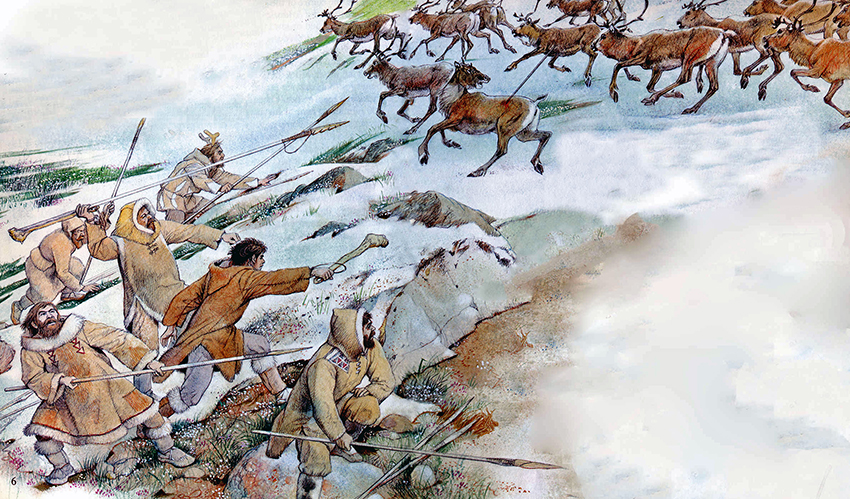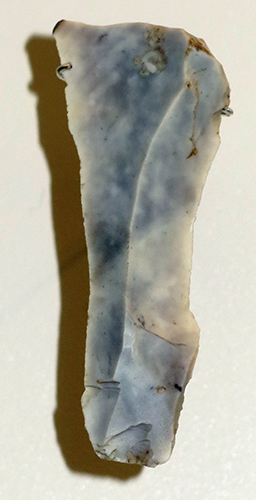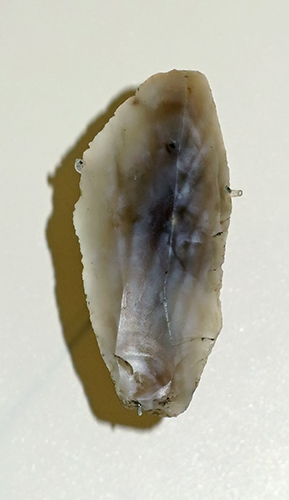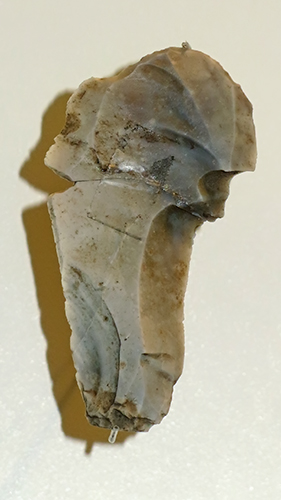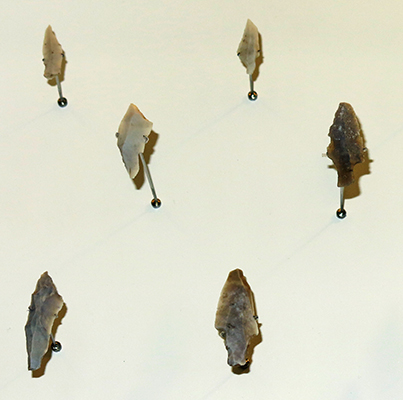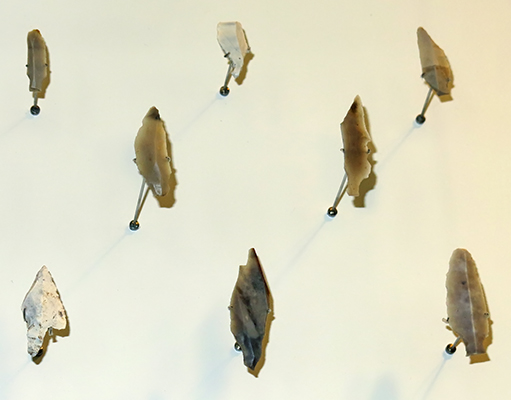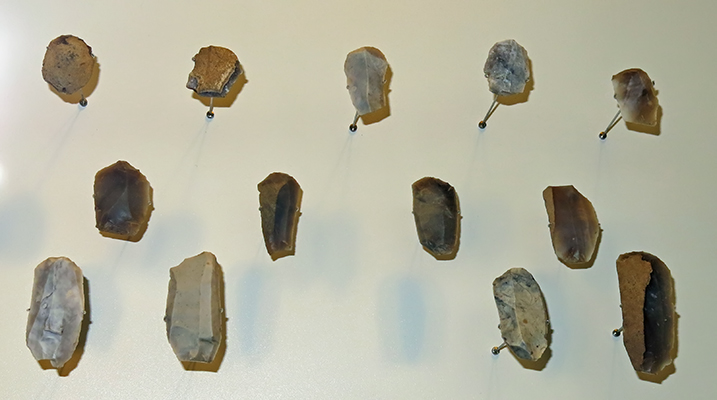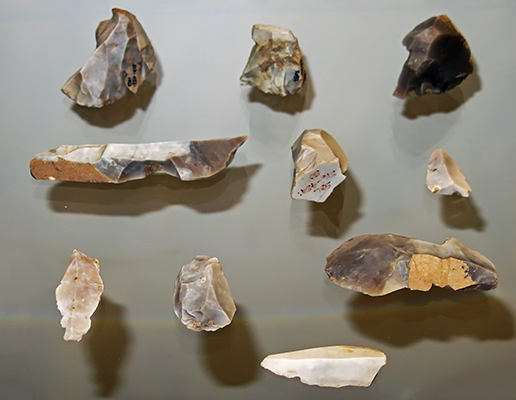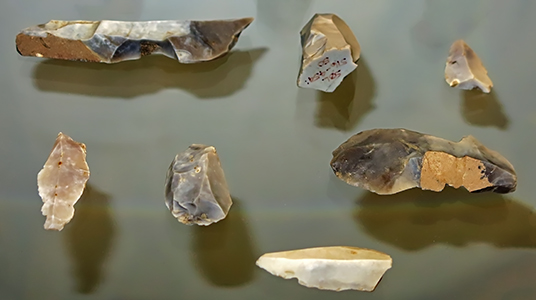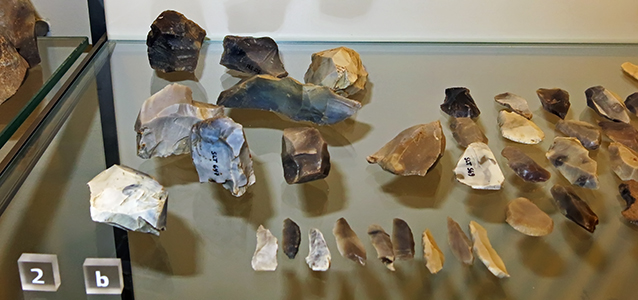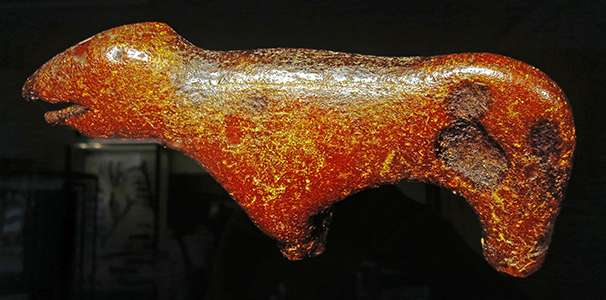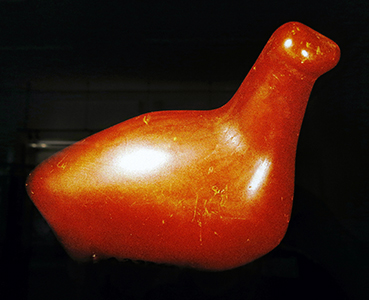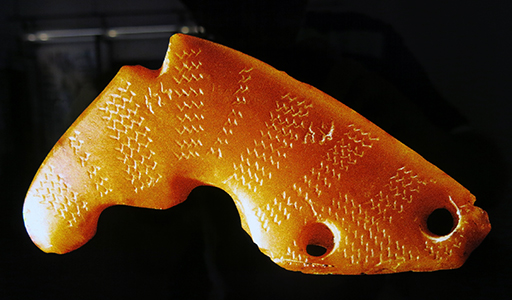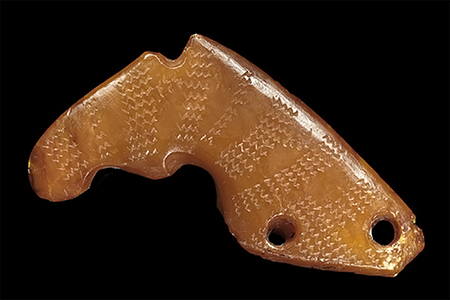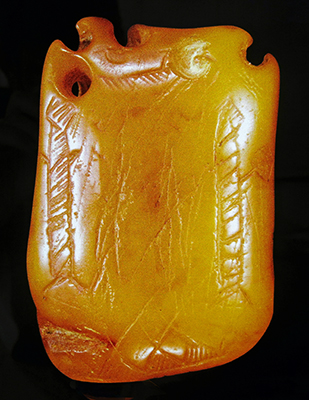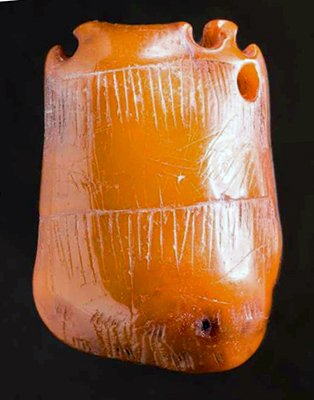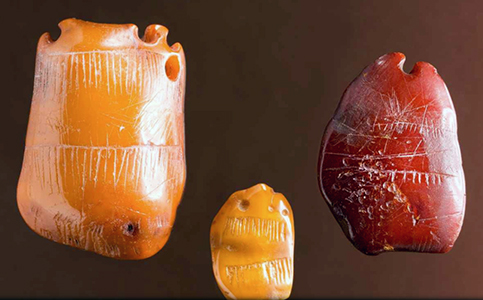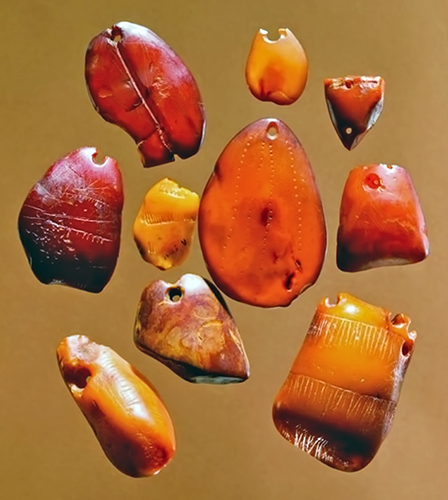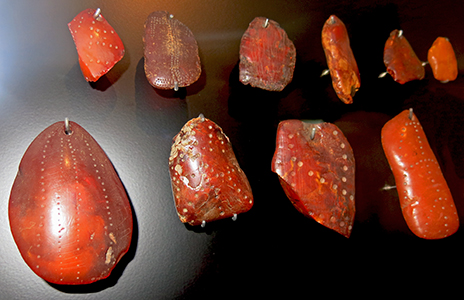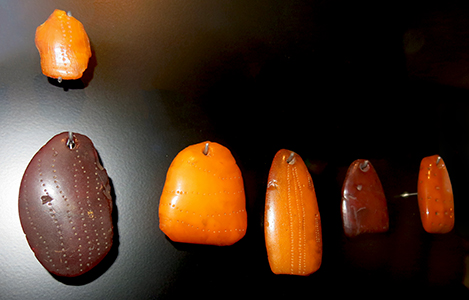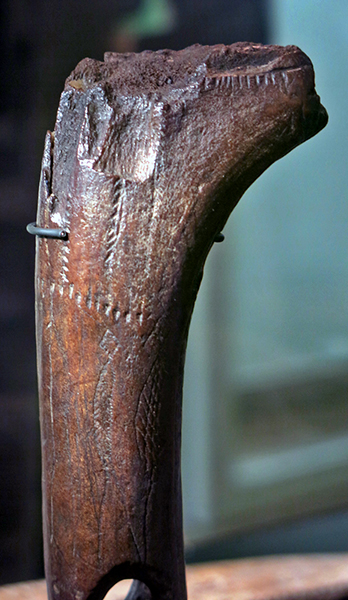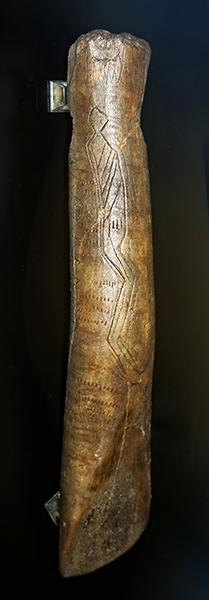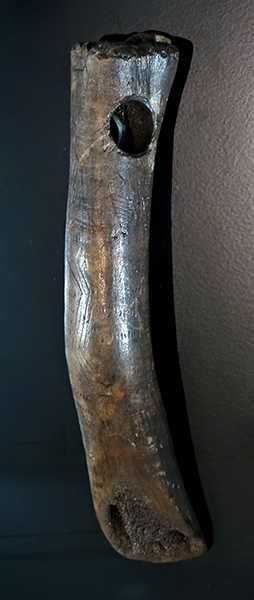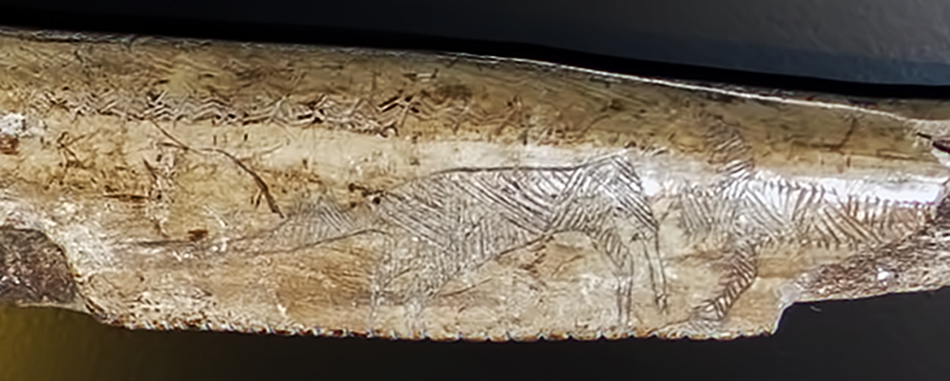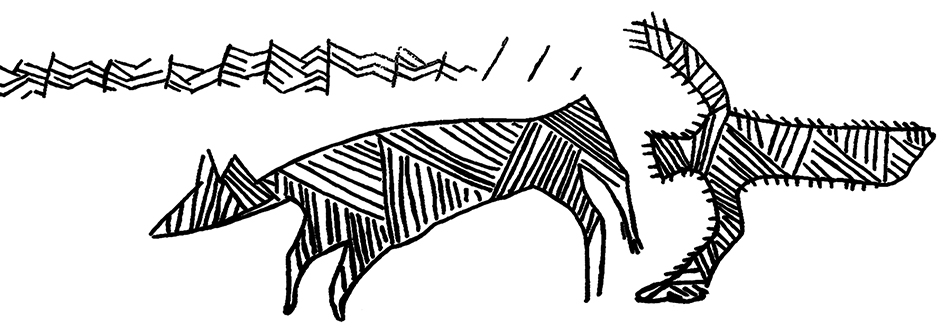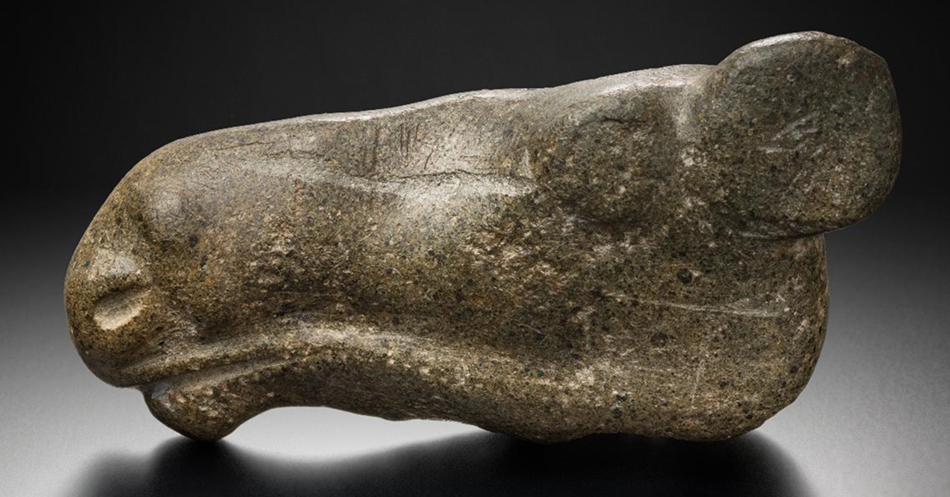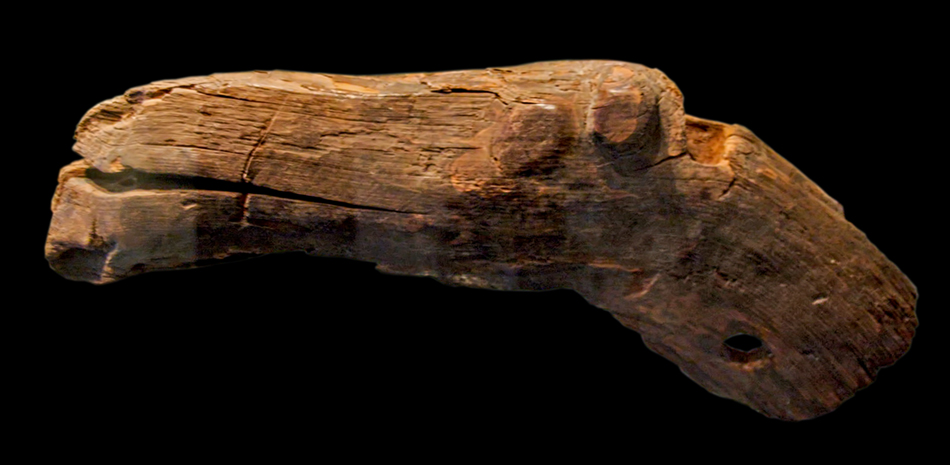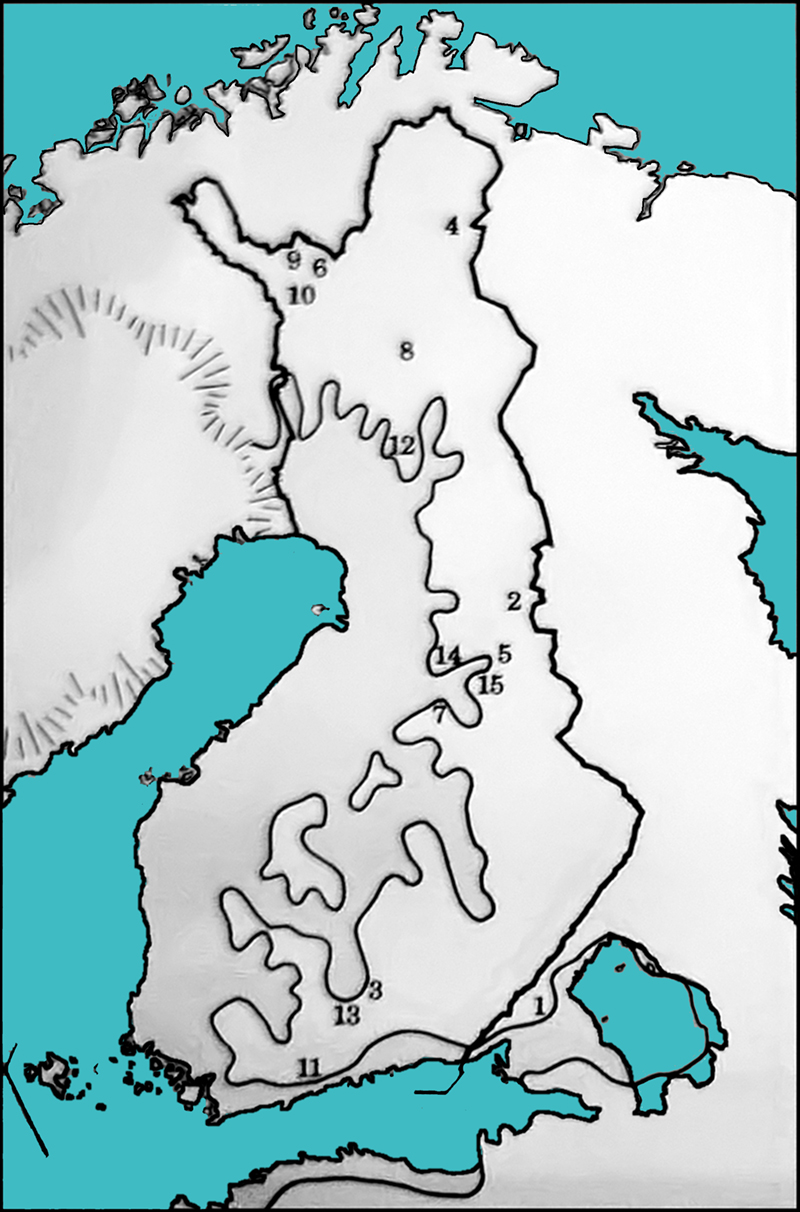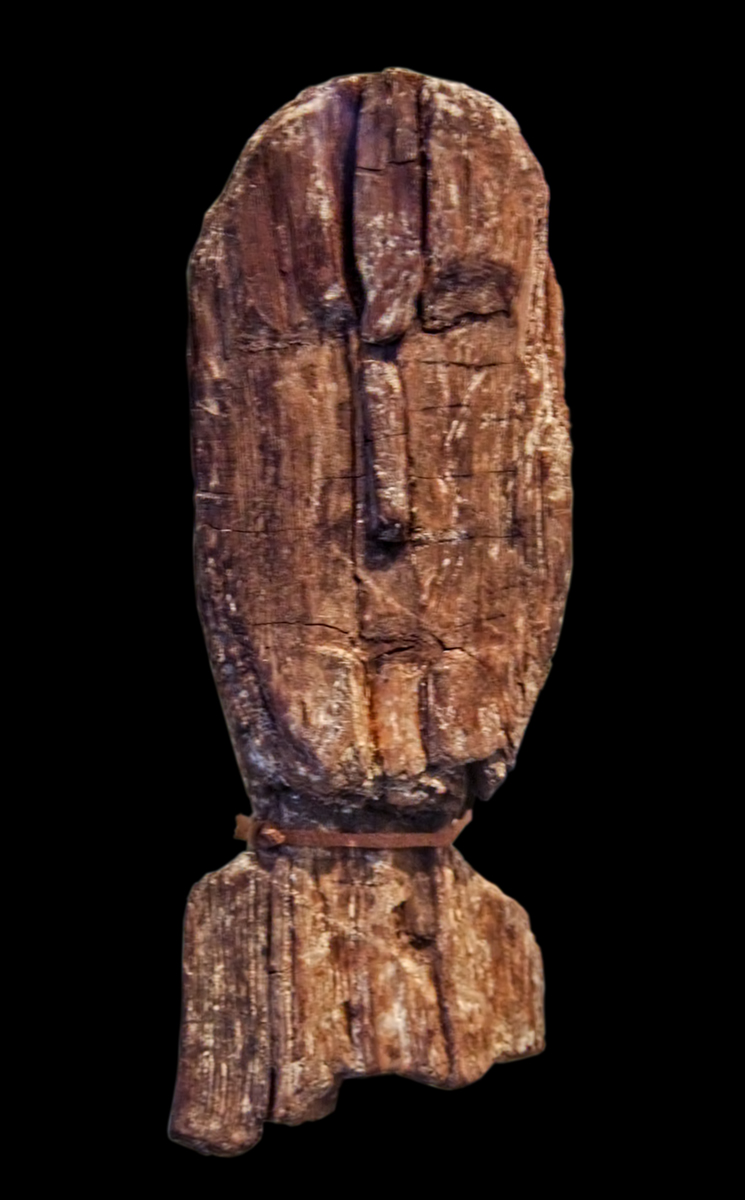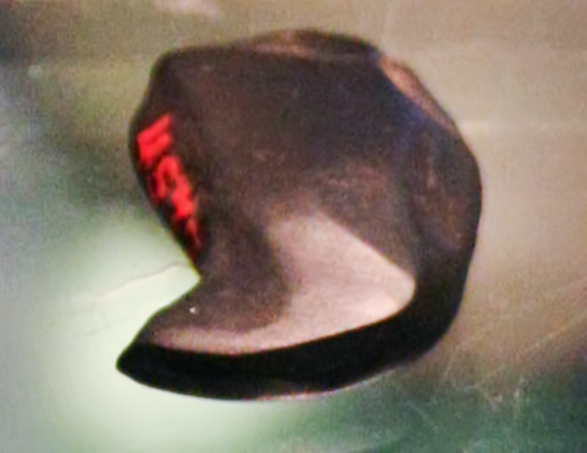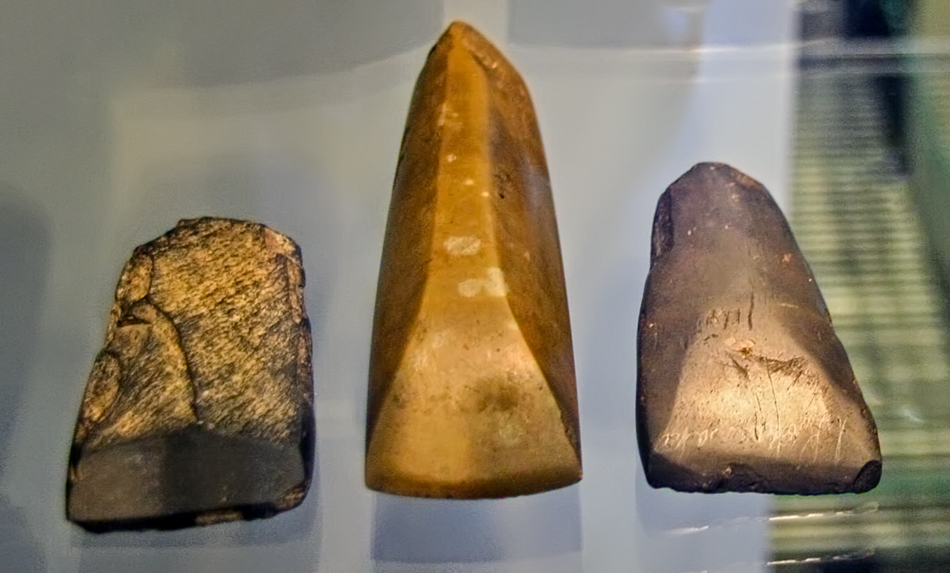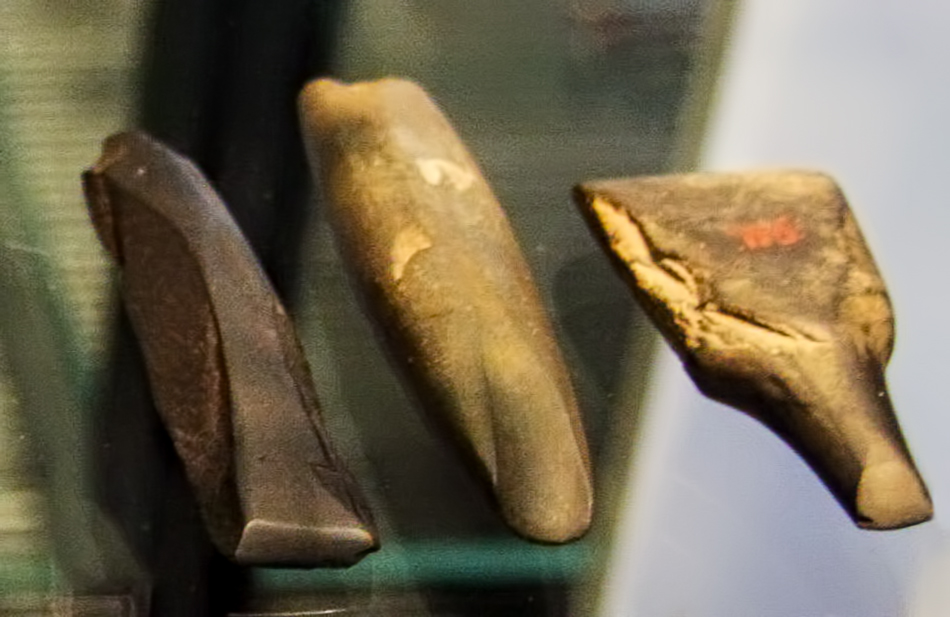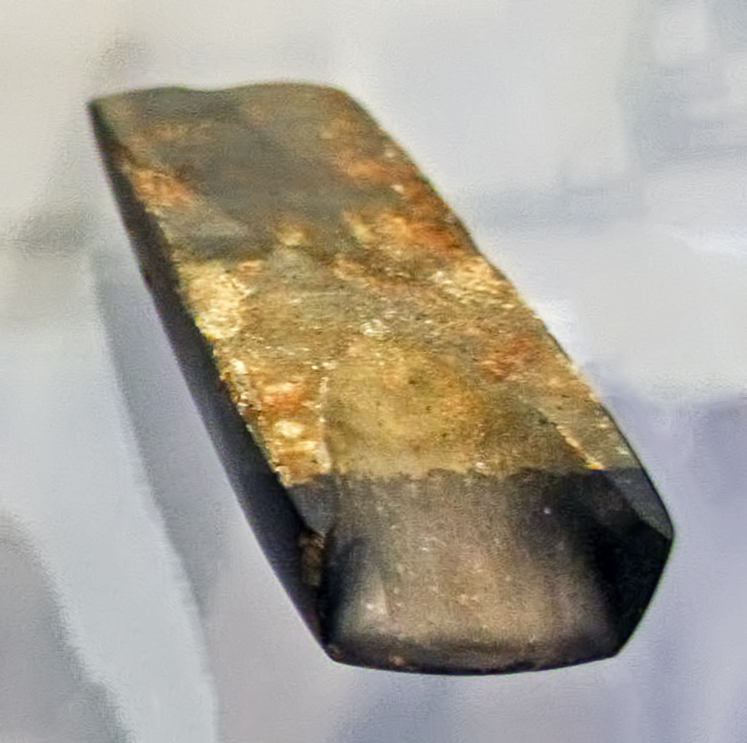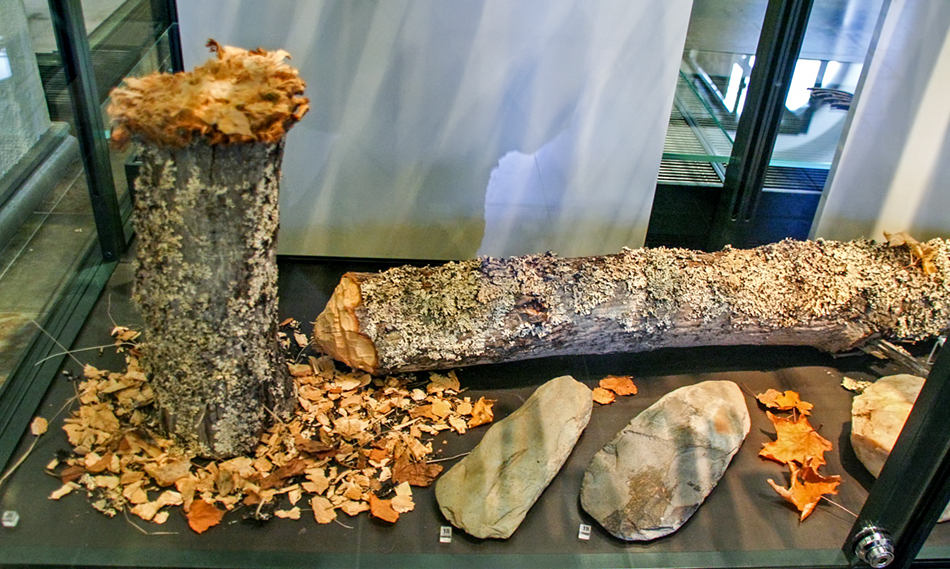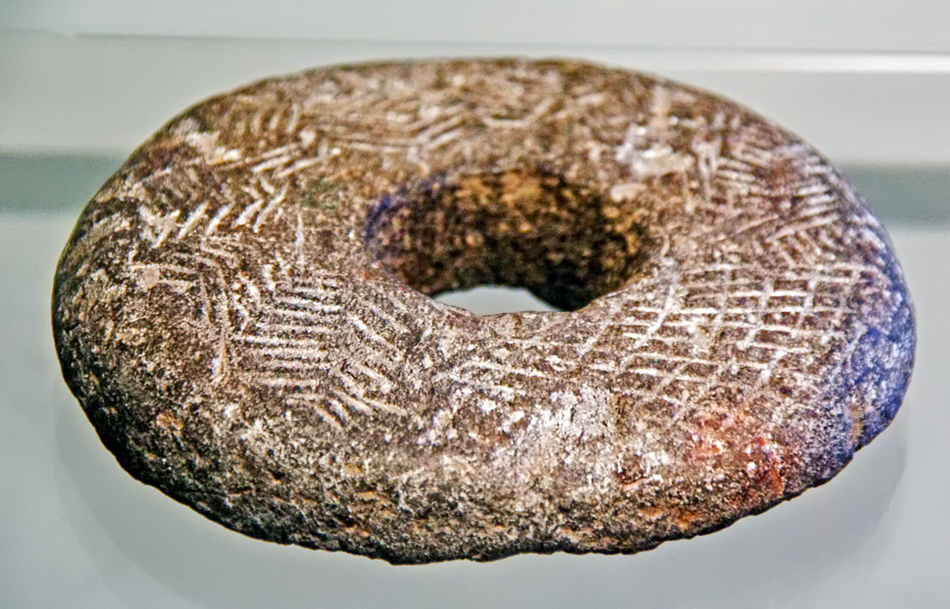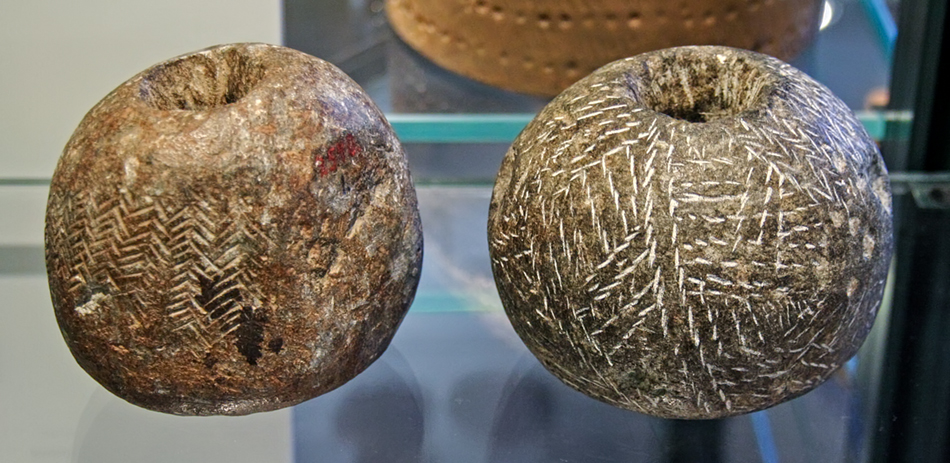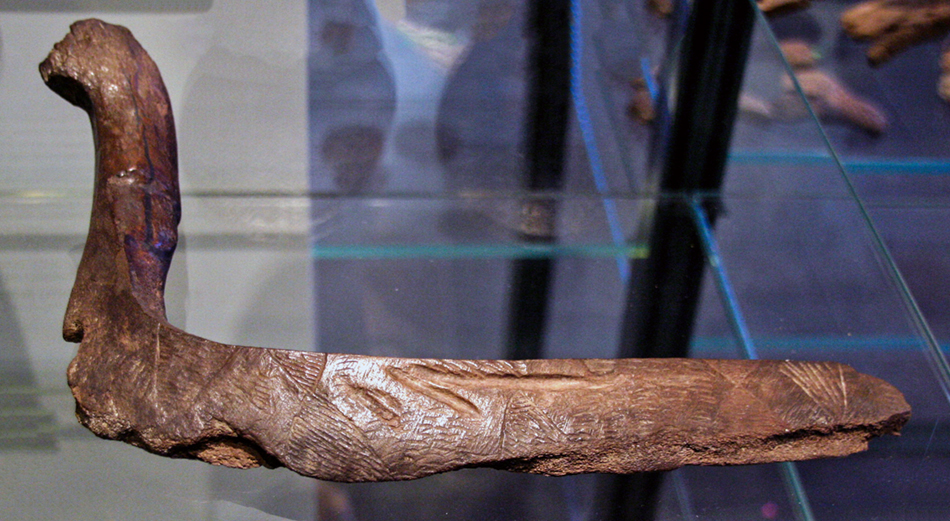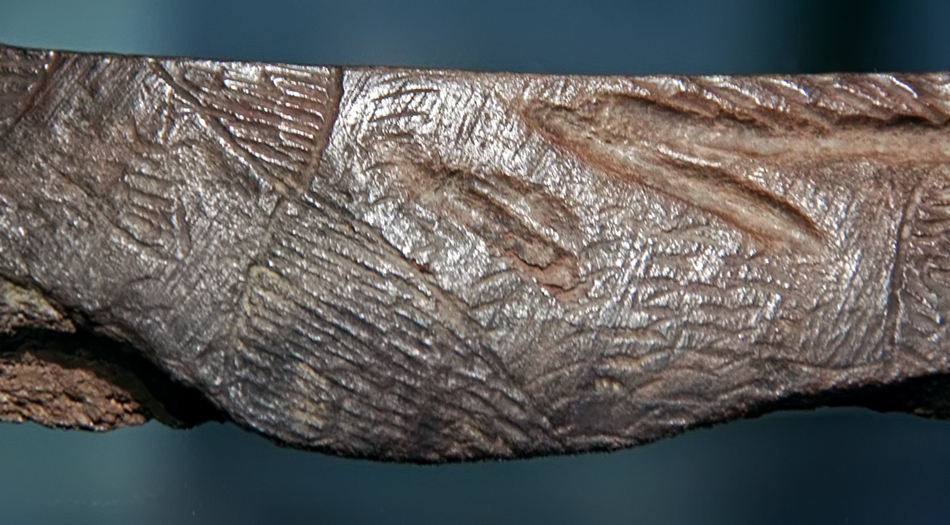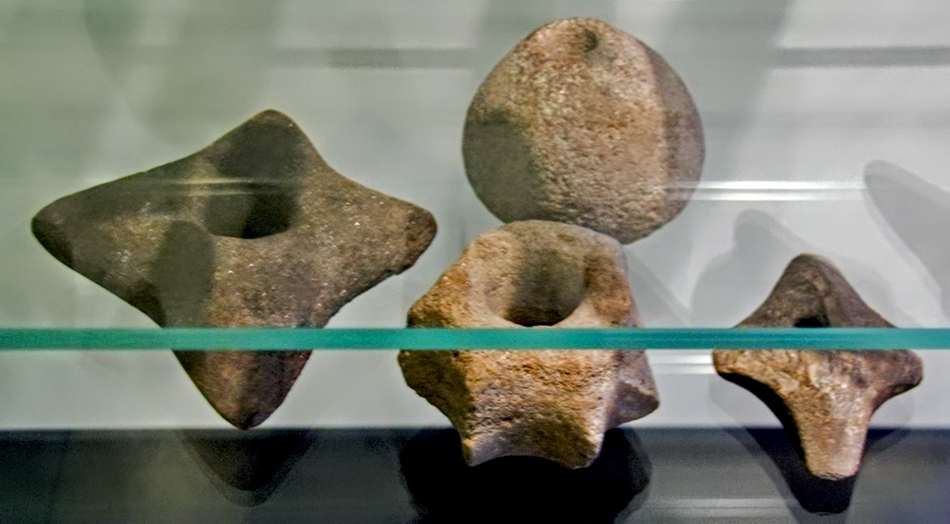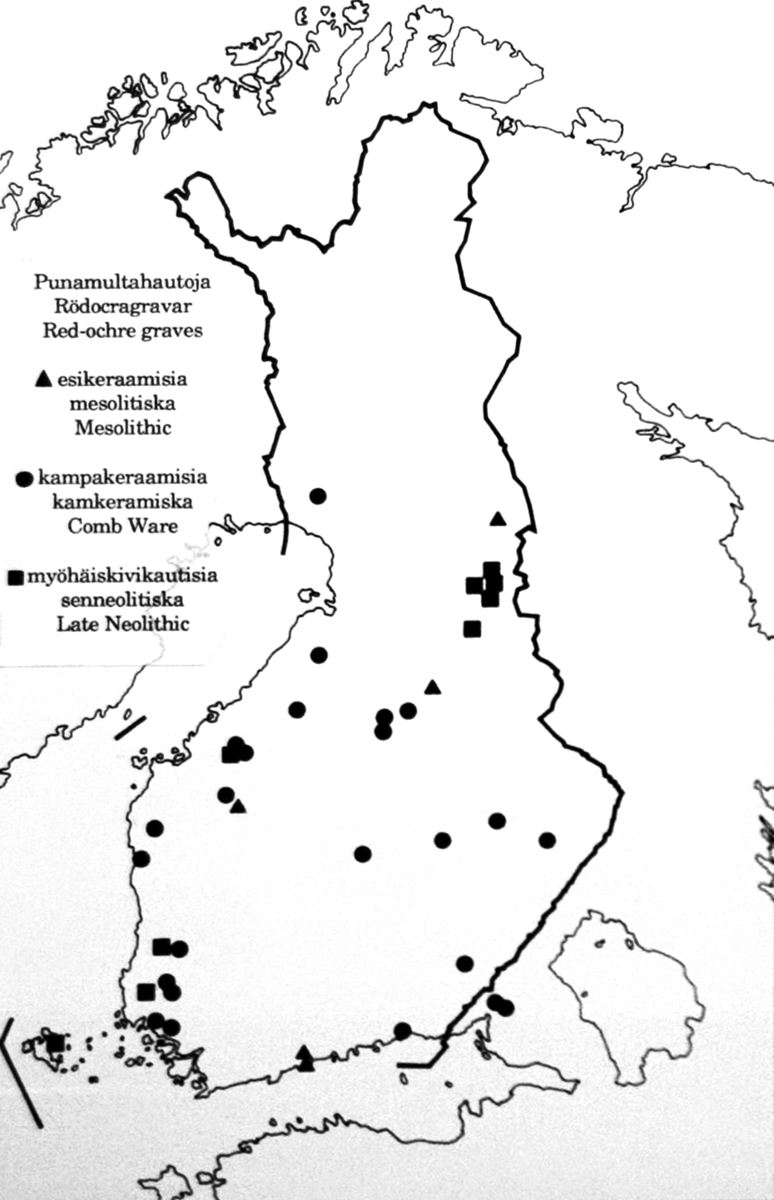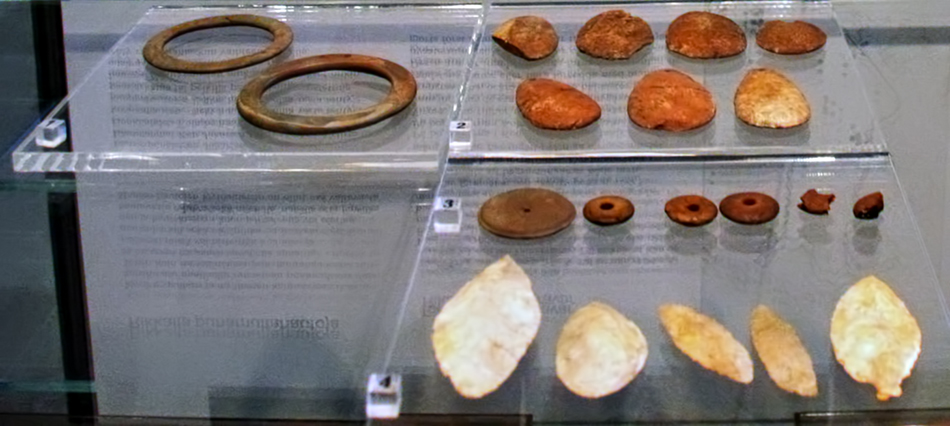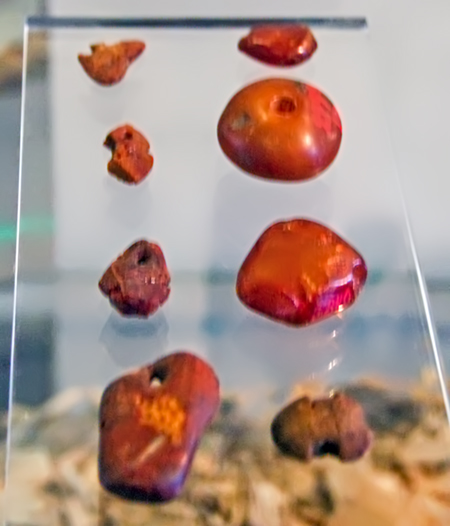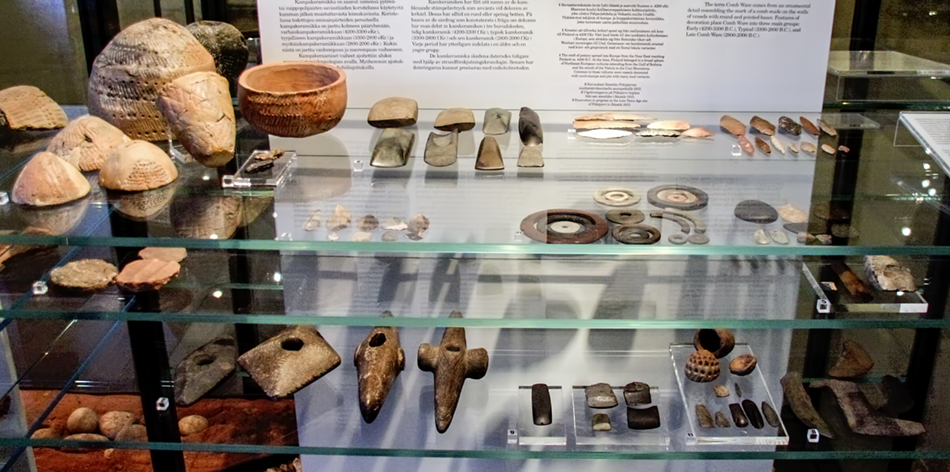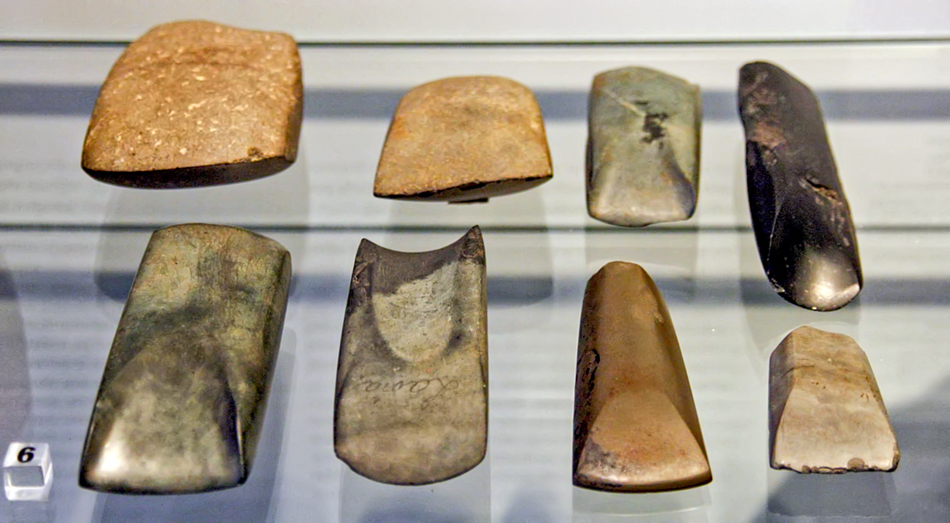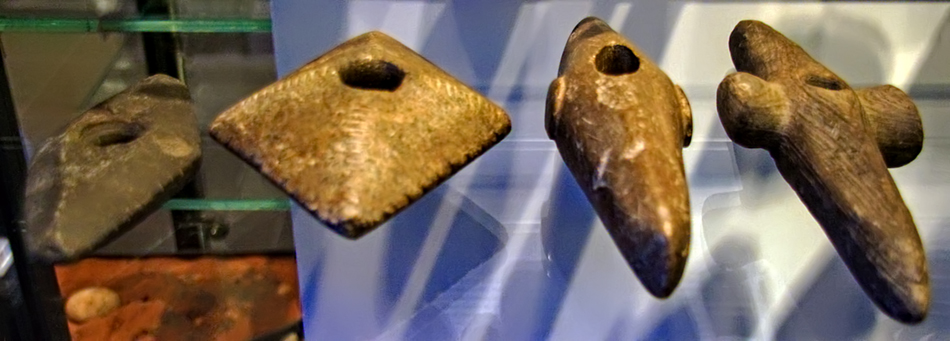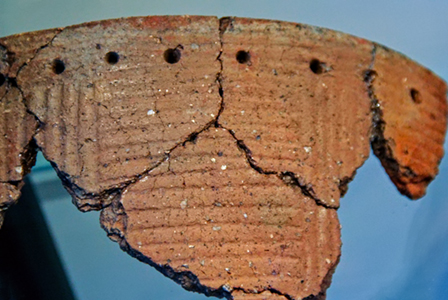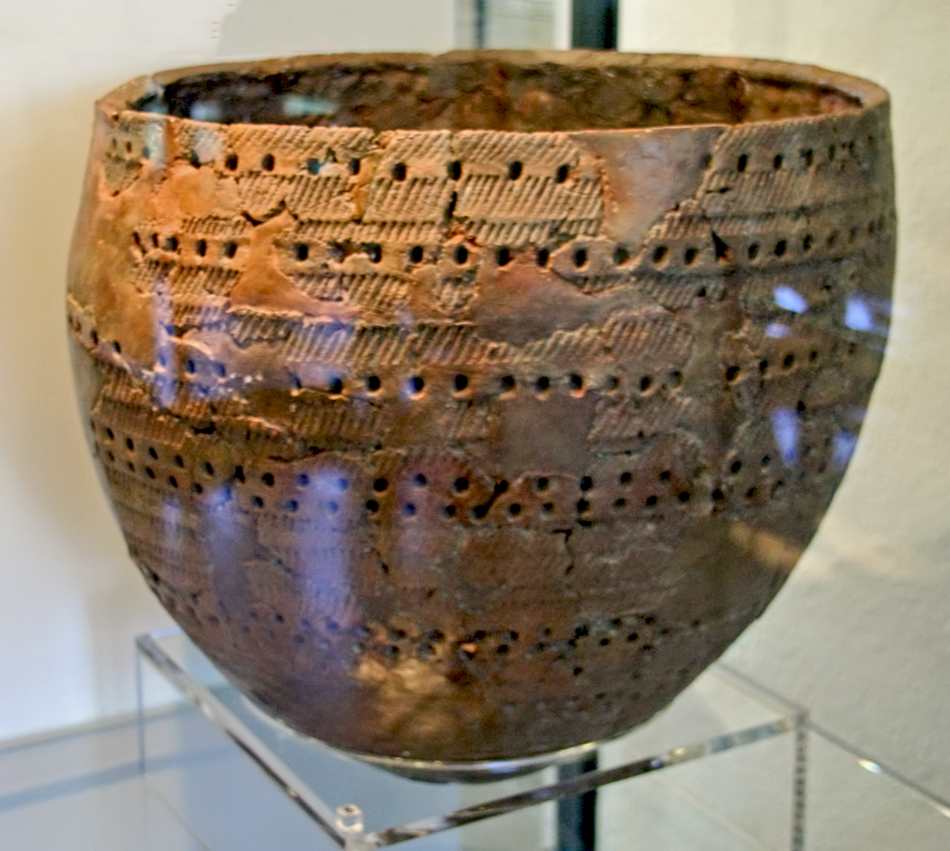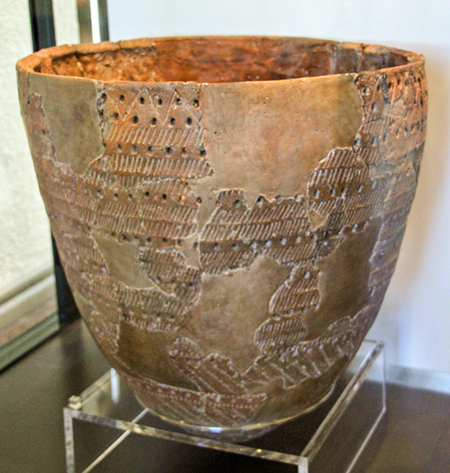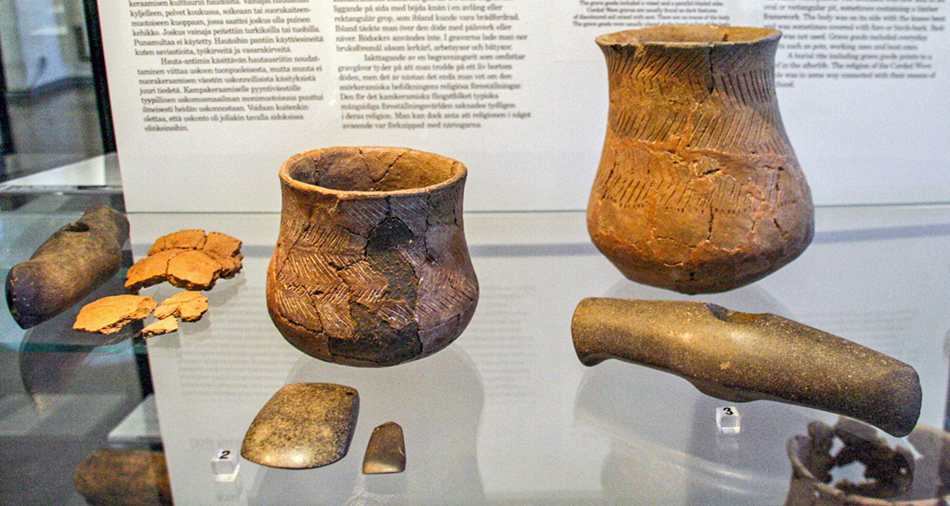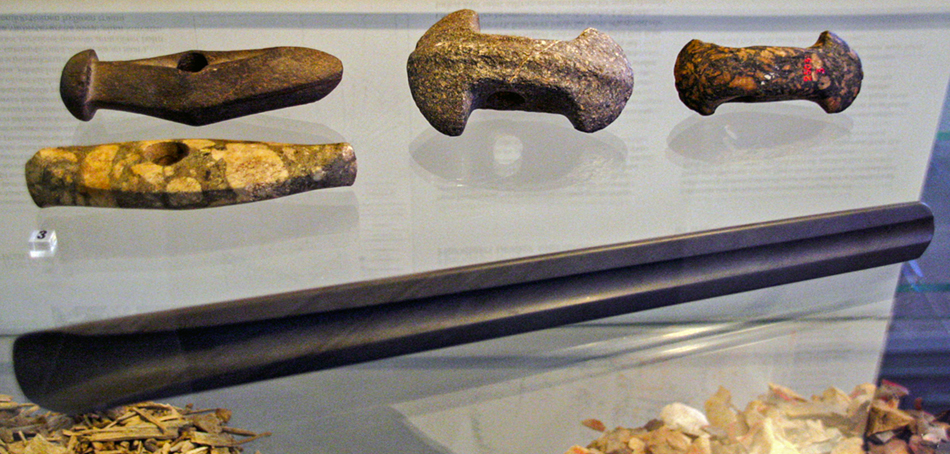Back to Don's Maps
 Back to Archaeological Sites
Back to Archaeological Sites
Ice Age Hunters in Northern Europe
Ice age hunters of Northern Europe, hunting reindeer and elk as well as utilising other food and shelter resources, moved into the periglacial tundras after the last Glacial Maximum, ca 20 000 BP
When hunting reindeer, the band cooperated closely. Their long, thin and flexible darts were launched from a spear thrower or atlatl, which was a lever which allowed the hunters to get a much greater range and force for their shafts. The darts were armed with both flint blades, especially the characteristic shouldered or tanged points of the Havelte type, and with barbed antler harpoons.
Reindeer antler is a strong, tough material, much stronger than, for example, red deer antler, and could be made into harpoon heads which were quite capable of bringing down an adult reindeer with one shot, a good cast blasting a hole through the shoulder blade of the reindeer, and immobilising the joint. This allowed the hunters to close with the animal, and finish it off.
The hunters aimed for the lifeline, a line connecting the heart and the mouth, and any spear which hit in that area would likely drop the reindeer in its tracks.
The animal would be dressed on the spot, with the abdominal cavity cleaned out and left for scavengers, and only the high value parts of the reindeer carried back to camp, with the load distributed amongst the hunting band.
We think of harpoons (that is, barbed bone or antler spear points) as being used for fish and large sea animals such as seals and whales, but they were first developed for reindeer hunting, and only later adapted for use with fish and marine mammals.
Photo and text: Adapted from Caselli (1985)
Additional text: Bibby (1956)
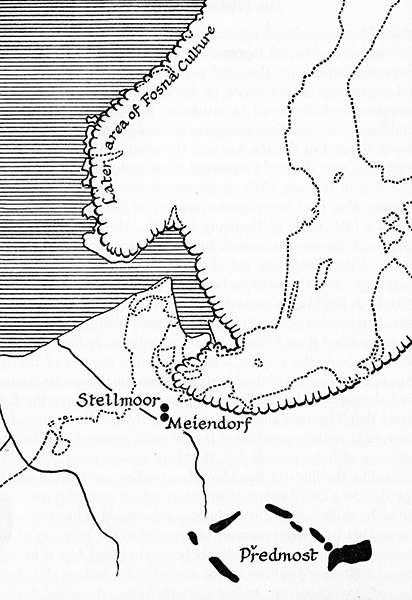
Northern Europe about 17 000 BP. The ice-cap has drawn back from all but the northern fringe of Germany, from the greater part of Denmark, and from the coasts of Norway. The sea, swollen by the melting ice, is creeping across the North Sea Plain to meet the Reindeer Hunters, whose summer camps at Meiendorf and Stellmoor may well have been less than 30 miles from the eternal ice.
Photo and text: Bibby (1956)

The darts and spear thrower were carefully made. The head of the spear often had a harpoon carved from reindeer antler instead of a flint point, with the harpoon mounted in such a way that it parted company with the shaft when the reindeer was struck, and there was less chance of either being broken.
The spear thrower gave much greater speed and distance to the spear because of the extra leverage gained.
A broken point or harpoon could be easily replaced in the field, but a dart was a big investment of time and effort, and was difficult to replace when there were few trees around, as was the case in the summer grazing grounds in the tundra.
One big advantage given by the development of the bow and arrow was that the shafts of the arrows were much shorter and thinner than darts, and very much easier to replace.
In addition, instead of just two or three unwieldy spears carried in the hand, dozens of arrows could be carried in a quiver on the back of the hunter, and the bow and arrow combination allowed the hunter to move into position quickly and easily, and to fire multiple shafts in a few seconds.
Photo: Caselli (1985)
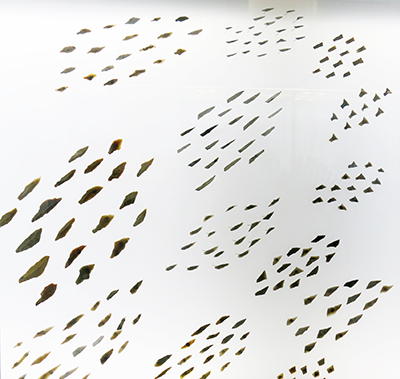
This is by far the most beautiful display of flint tools I have ever seen. It is a work of art in itself, and a tribute to the staff of the museum.
The Cro-Magnons hunted with light spears thrown with atlatls, propulseurs. Bows and arrows only came later - when is uncertain - but at the end of the Ice Age we find arrow shafts with notches for bowstrings in the Ahrensburg Culture, ca 11 000 BP.
Throwing spears and arrows had sharp flint points shaped according to changing fashions; the soil still contains relics of 10 000 years of hunting - the small arrowheads of flint that made the hunters' weapons so fatally effective.
Photo: Don Hitchcock 2014
Source and text: Original, Københavns (Copenhagen) Museum, National Museum of Denmark
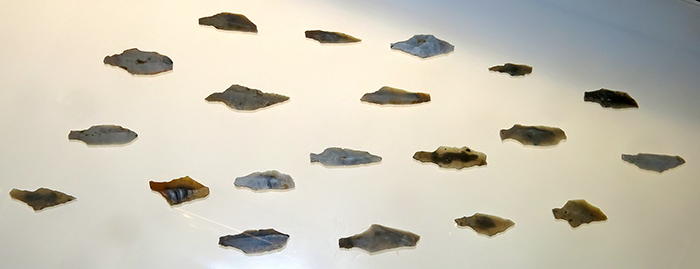
Shouldered points.
Photo: Don Hitchcock 2014
Source: Original, Københavns (Copenhagen) Museum, National Museum of Denmark
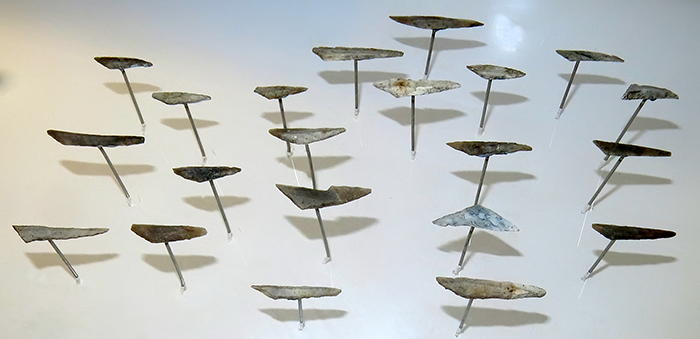
Flint points.
Photo: Don Hitchcock 2014
Source: Original, Københavns (Copenhagen) Museum, National Museum of Denmark
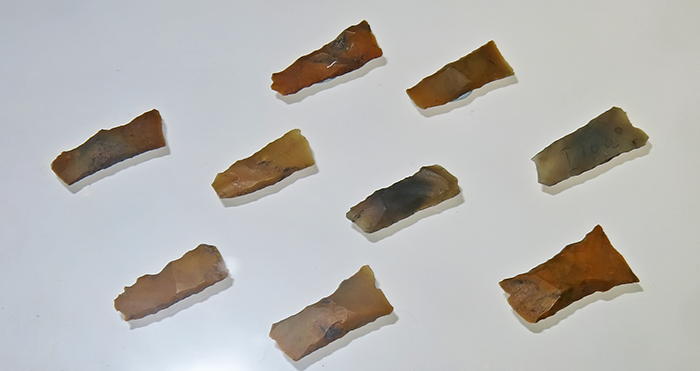
Microblades.
Photo: Don Hitchcock 2014
Source: Original, Københavns (Copenhagen) Museum, National Museum of Denmark
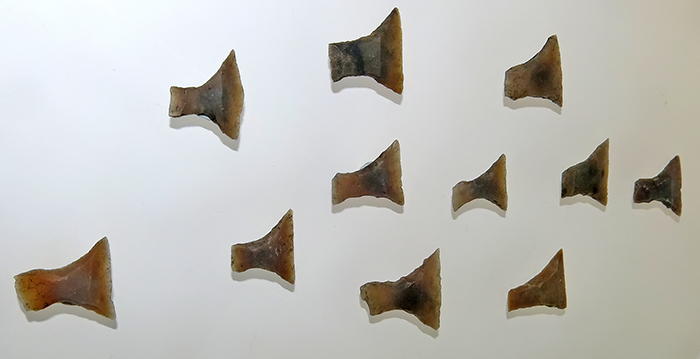
Trapezoidal microblades.
My thanks to Thomas Quinn, who pointed out that these blades were used as arrow points, especially for birds and small game.
Photo: Don Hitchcock 2014
Source: Original, Københavns (Copenhagen) Museum, National Museum of Denmark
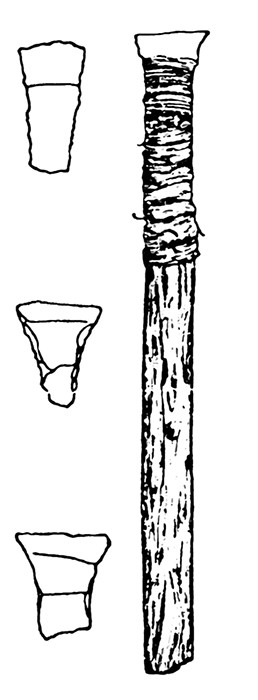

Transverse arrowheads
(left) Trapezoid microliths and an arrow with a trapezoidal microlith used as an arrow tip, found nearly three metres deep in a peat bog at Tværmose, Eising Sogn, Ginding Herred, North Jutland (Denmark).
The chisel-ended arrow was developed and extensively used in ancient Egypt for the shooting of birds
(left) Photo and text: Clark (1936)
Additional text: Wikipedia
(right) Transverse arrowheads with their hafting still intact are very rare. This one is also from Tværmose near Ringkøbing on the west coast of the Denmark (Jutland) peninsula.
Some of the most well-known flint objects from the Stone Age are arrowheads. They can be found all over Denmark, in places where the Stone Age hunters missed their targets. These have then been discovered thousands of years later; the arrowheads of flint are well preserved, whereas the wooden arrow shafts have decomposed. The so-called transverse flint arrowheads are shaped so that they have a very broad cutting edge.
This is useful when hunting large prey. The broad cutting edge causes severe injuries to the animals, that bleed to death relatively quickly and are unable to move far away from the hunter. Arrowheads are sometimes found which have been exposed to heat. Apparently these have remained lodged in the body of the animal when it was cooked.
(right) Photo and text: http://en.natmus.dk/historical-knowledge/denmark/prehistoric-period-until-1050-ad/the-mesolithic-period/the-stone-age-hunters-bow-and-arrow/the-transverse-arrowheads-of-the-stone-age/
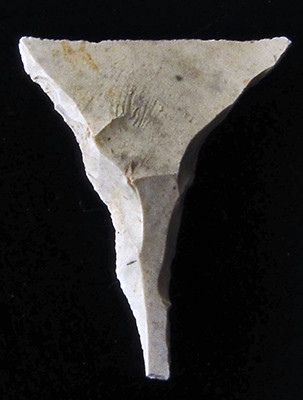
This is an extreme form of a trapezoid microlith from Denmark belonging to the late Kongemose or Ertebölle time horizon, which is part of the late Mesolithic of this region.
It could only have been used as a point on a chisel ended arrow.
The photo comes from Katzman's excellent Palaeolithic blog, http://www.aggsbach.de
Photo: Katzman
Text: adapted from http://www.aggsbach.de/2014/04/microlithic-tools-during-the-late-mesolithic-of-europe/
Source: http://www.aggsbach.de/2014/04/microlithic-tools-during-the-late-mesolithic-of-europe/
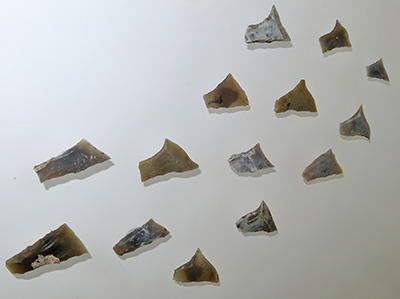
Trapezoidal microblades.
Photo: Don Hitchcock 2014
Source: Original, Københavns (Copenhagen) Museum, National Museum of Denmark
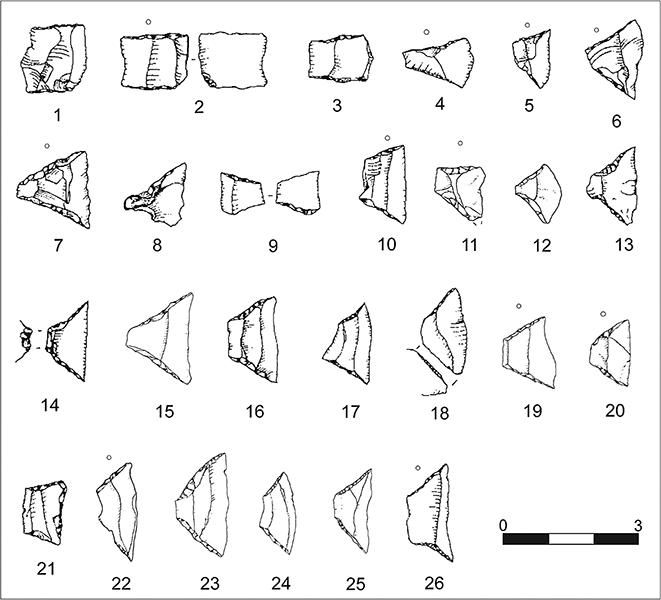
There was no scale on the superb display of microblades. These drawings show that the typical trapezoidal microblade was 15 mm to 20 mm on the longest side.
Trapezoids recovered at La Cogola shelter (1-4, 6, 8, 12, 15, 24, 29) and Bus de La
Lum (7, 9-11, 16, 19-23, 25-28, 30-34, 36)
Drawings: G. Almerigogna, S. Ferrari, A. Paolillo.
Source and text: Dalmeri et al. (2002)

Late-glacial sites with trapezoids in Europe. Bigger points correspond to groups of sites.
1 Pinar de Tarruella. - 2 L’Areny. - 3 La Gare de Couza. - 4 Grotta delle Arene Candide. - 5
Grotta di Palidoro. - 6 Grotta Polesini. - 7 Grotta di S.Teodoro. - 8 Grotta dell’Acqua Fitusa. -
9 Grotta Giovanna, Grotta Corruggi. - 10 Grotta del Cavallo. - 11 Grotta Romanelli, Grotta
Zinzulusa. - 12 Grotta Santa Croce. - 13 Grotta Paglicci. - 14 Grotta del Prete. - 15 Riparo
Soman, Riparo Villabruna, Bus de La Lum, Val Lastari, Riparo La Cogola and Riparo Dalmeri..
- 16 Kadar. - 17 Crvena Stijena. - 18 Asprochaliko. - 19 Franchti. - 20 Nova Kakhovka. - 21
Tsarinka, Ivashkovo VI. - 22 Shan-Coba, Fatma-Coba, Zamil-Coba, Vodopadny, Buran-Kaya,
Alimivsky, Sy-At III. - 23 Suren II. - 24 Bilolissya. - 25 Leontivka, Drimajlivka. - 26 Osokorivka
3B, Progon. - 27 Molodova I. - 28 Rogalik. - 29 Pisochny Riv. - 30 Nezvisko. - 31 Pavlov. - 32
Kulna Cave. - 33 Kvìc. - 34 Borneck, Stellmoor. - 35 Zonhoven, Grotte de Remouchamps.
Source and text: Dalmeri et al. (2002)
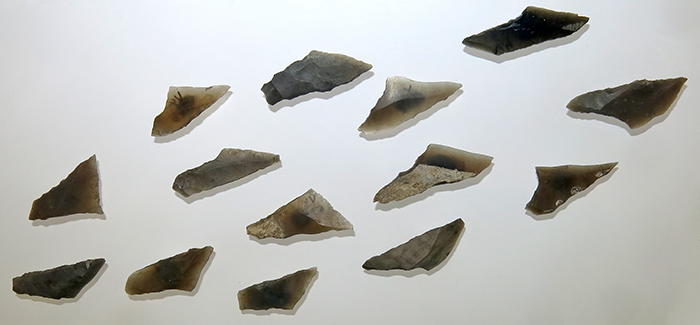
Microblades of this type were more likely to have been used as part of a composite point, glued in grooves carved on each side of the bone point of an arrow. See the photos immediately below.
Photo: Don Hitchcock 2014
Source: Original, Københavns (Copenhagen) Museum, National Museum of Denmark
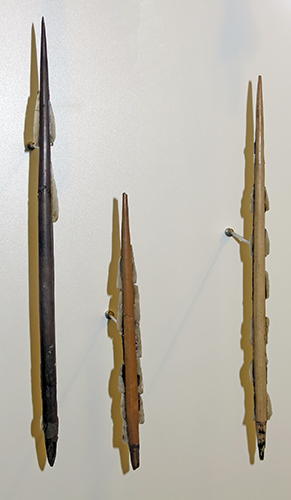
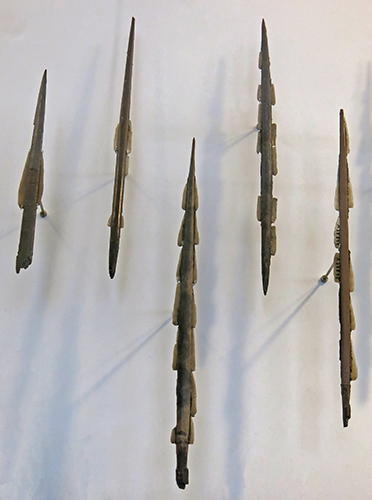
Bone projectile points edged with flint blades glued on with tar extracted from birch bark. Found during peat-digging in various bogs. Maglemose and Kongemose Cultures, 10 700 - 7 500 BP.
( while such composite and complicated points would have required a large amount of effort, skill, and time to complete, the results were obviously worth it.
It would seem to me that they were most likely to be used on larger game such as deer and moose, where the damage done by such an array of very sharp edges would have brought the animal to a standstill very quickly because of shock. - Don )
Photo: Don Hitchcock 2014
Source and text: Apparently originals, Københavns (Copenhagen) Museum, National Museum of Denmark.
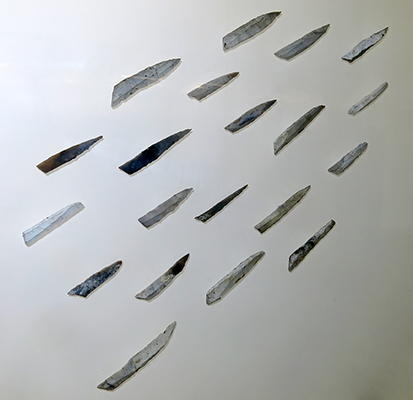
Flint points.
Photo: Don Hitchcock 2014
Source: Original, Københavns (Copenhagen) Museum, National Museum of Denmark
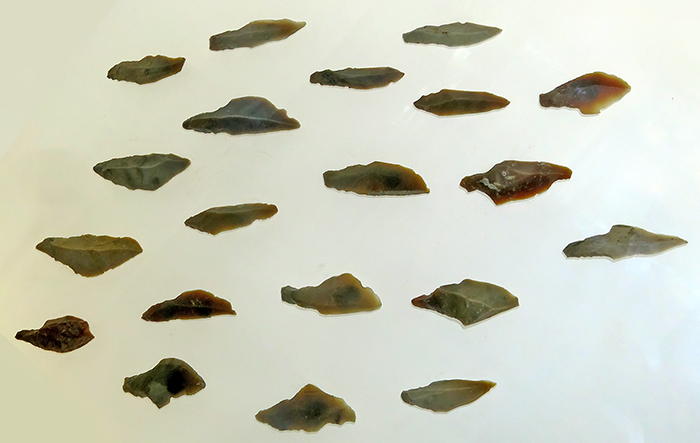
Shouldered points.
Photo: Don Hitchcock 2014
Source: Original, Københavns (Copenhagen) Museum, National Museum of Denmark

Flint points.
Photo: Don Hitchcock 2014
Source: Original, Københavns (Copenhagen) Museum, National Museum of Denmark
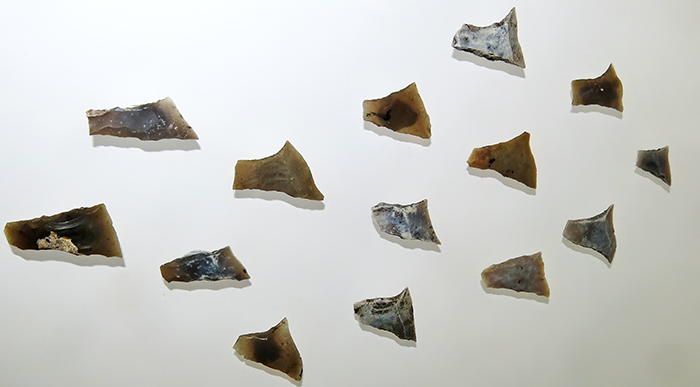
Trapezoidal microblades.
Photo: Don Hitchcock 2014
Source: Original, Københavns (Copenhagen) Museum, National Museum of Denmark
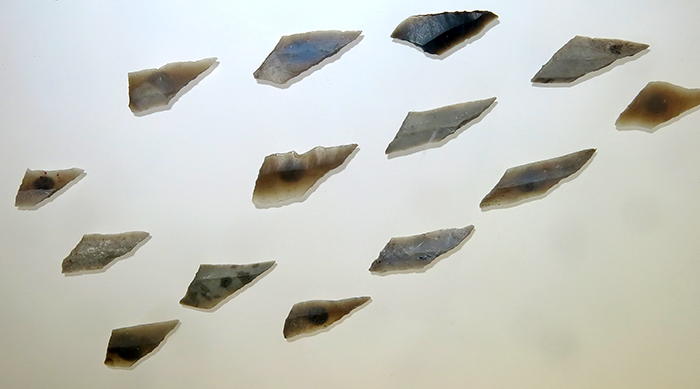
Flint points.
Photo: Don Hitchcock 2014
Source: Original, Københavns (Copenhagen) Museum, National Museum of Denmark
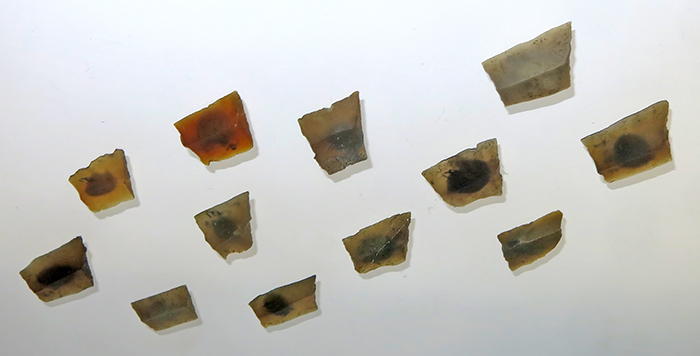
Trapezoidal microblades.
Photo: Don Hitchcock 2014
Source: Original, Københavns (Copenhagen) Museum, National Museum of Denmark
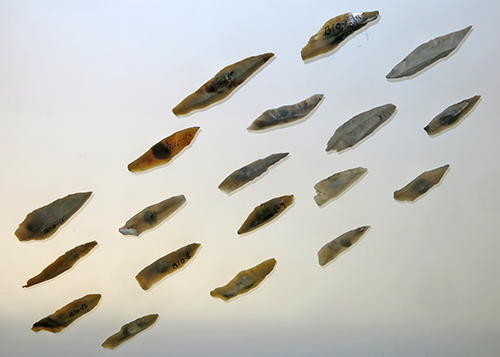
Flint points.
Photo: Don Hitchcock 2014
Source: Original, Københavns (Copenhagen) Museum, National Museum of Denmark

Shouldered points.
Photo: Don Hitchcock 2014
Source: Original, Københavns (Copenhagen) Museum, National Museum of Denmark

Flint point.
Photo: Don Hitchcock 2014
Source: Original, Københavns (Copenhagen) Museum, National Museum of Denmark
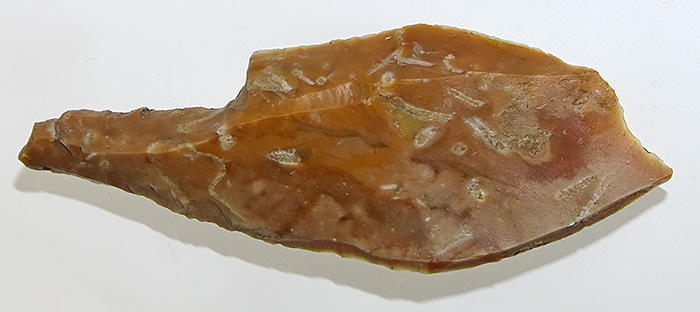
Shouldered point.
Photo: Don Hitchcock 2014
Source: Original, Københavns (Copenhagen) Museum, National Museum of Denmark
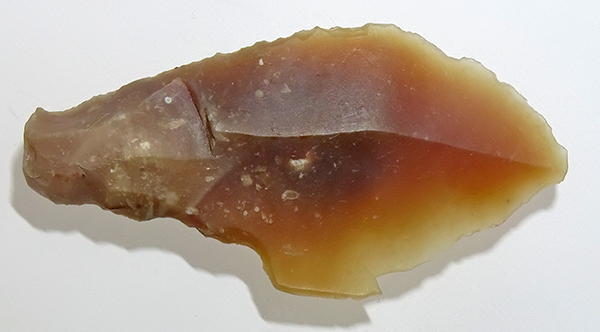
Shouldered point.
Photo: Don Hitchcock 2014
Source: Original, Københavns (Copenhagen) Museum, National Museum of Denmark

Shouldered point with a very distinct 'tang'.
Photo: Don Hitchcock 2014
Source: Original, Københavns (Copenhagen) Museum, National Museum of Denmark

Shouldered point.
Photo: Don Hitchcock 2014
Source: Original, Københavns (Copenhagen) Museum, National Museum of Denmark
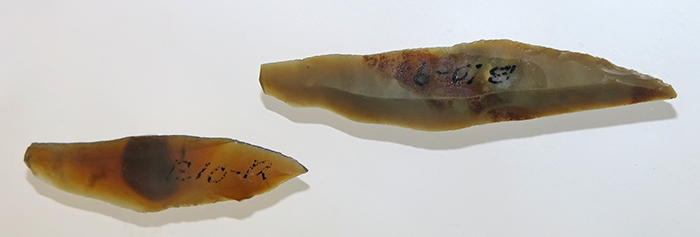
Flint points.
Photo: Don Hitchcock 2014
Source: Original, Københavns (Copenhagen) Museum, National Museum of Denmark

Microliths. These are remarkably similar in shape to Australian 'Adelaide' points.
Photo: Don Hitchcock 2014
Source: Original, Københavns (Copenhagen) Museum, National Museum of Denmark
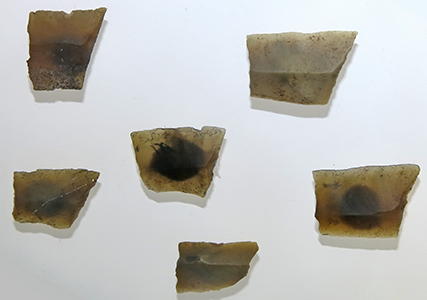
Trapezoid microliths.
Photo: Don Hitchcock 2014
Source: Original, Københavns (Copenhagen) Museum, National Museum of Denmark
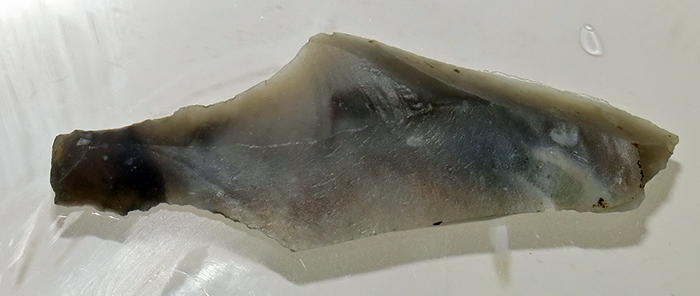
Shouldered point.
Photo: Don Hitchcock 2014
Source: Original, Københavns (Copenhagen) Museum, National Museum of Denmark

Microliths.
Photo: Don Hitchcock 2014
Source: Original, Københavns (Copenhagen) Museum, National Museum of Denmark
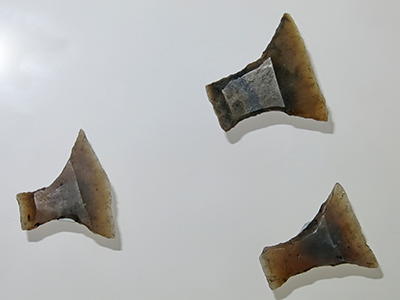
Trapezoid microliths.
Photo: Don Hitchcock 2014
Source: Original, Københavns (Copenhagen) Museum, National Museum of Denmark
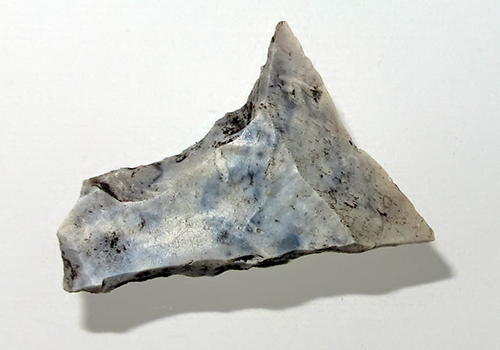
Trapezoid microlith.
Photo: Don Hitchcock 2014
Source: Original, Københavns (Copenhagen) Museum, National Museum of Denmark

Shouldered point.
Photo: Don Hitchcock 2014
Source: Original, Københavns (Copenhagen) Museum, National Museum of Denmark
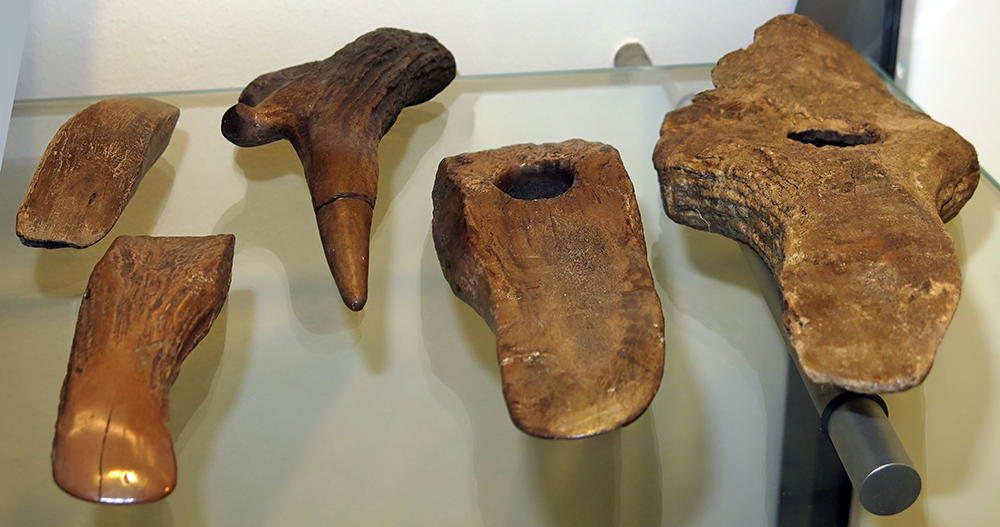
Elk antler axes, wedges and chisels. Found during peat-digging at various bogs.
Early Maglemose Culture, 10 700 - 9 000 BP.
Photo: Don Hitchcock 2014
Source: Original, Københavns (Copenhagen) Museum, National Museum of Denmark
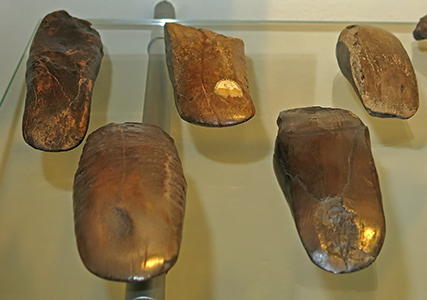
Elk antler wedges from the same display above. Found during peat-digging at various bogs.
Early Maglemose Culture, 10 700 - 9 000 BP.
Photo: Don Hitchcock 2014
Source: Original, Københavns (Copenhagen) Museum, National Museum of Denmark
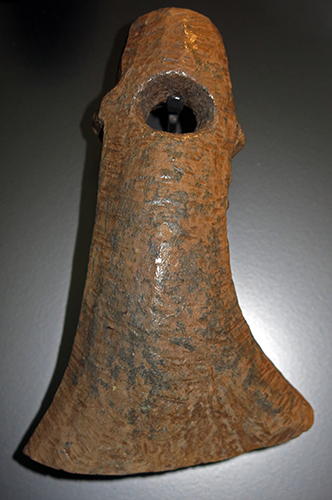
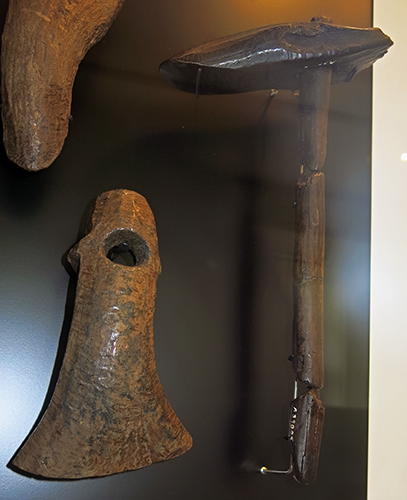
The tool on the left, apparently a facsimile, appears to be either an adze, or a handled wedge for splitting timber, made from moose /elk antler. Note that the maker has carefully put the hole for the handle at a thickening in the antler, to provide more strength at the junction, where much stress would be applied.
The tool on the right is an adze, and may be original.
Early Maglemose Culture, 10 700 - 9 000 BP.
Photo: Don Hitchcock 2014
Source: Københavns (Copenhagen) Museum, National Museum of Denmark
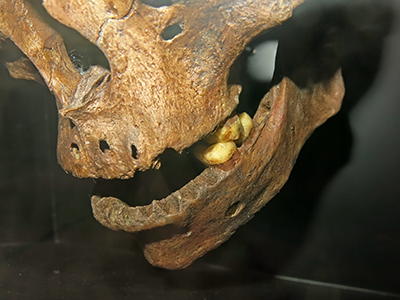
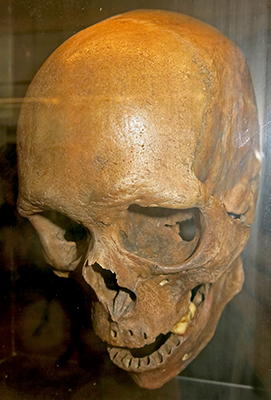
Towards the end of the Ice Age birch forests grew up. The last refuge of the now-extinct giant deer was the young forest landscape - ideal too for elk (moose) which ate the aquatic plants in the extensive wetlands. Hunters also gathered at the lakes, using harpoons to kill animals trying to swim away. After the quarry had been cut up the bones were sunk in the lake as hunting sacrifices. In a lake at Koelbjerg on Funen a woman drowned 10 000 years ago. She is the oldest known Dane.
This skull of the woman from Koelbjerg on Funen is typically Cro-Magnon. 10 500 BP.
Photo: Don Hitchcock 2014
Source and text: Facsimile, Københavns (Copenhagen) Museum, National Museum of Denmark
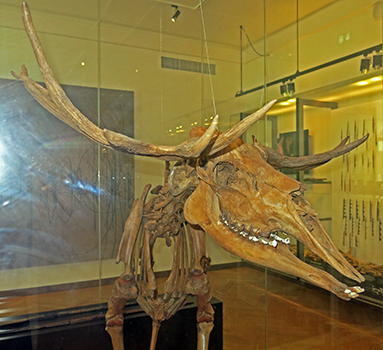
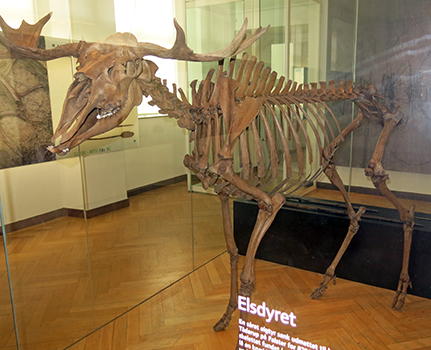
A wounded elk (moose) sank exhausted to the bottom of a lake at Tåderup on Falster 8700 years ago. In 1922 the skeleton was found in a peat bog. Among the bones was a broken bone point that may have been used in the hunt. Later a harpoon was found in the same peat bog.
Several kinds of tools and weapons were made from the large animals' antlers and slender bones. The hunting was so intensive that the species was wiped out in Zealand ca 8500 years ago. However the elk still played an important role in the hunters' mythology. Tooth beads, and tools of elk antler and bone were valuable barter objects.
Photo: Don Hitchcock 2014
Source and text: Københavns (Copenhagen) Museum, National Museum of Denmark.
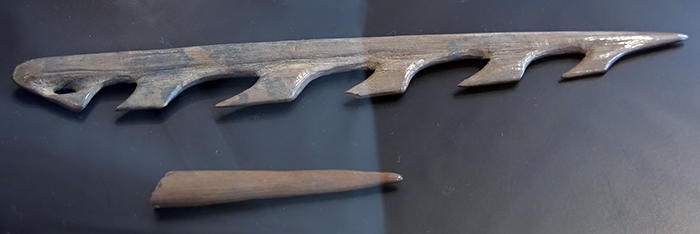
Bone harpoon, found near the elk skeleton. Tåderup, Falster, ca 8700 BP.
Bone point, broken, found among the elk's remains. Tåderup, Falster, ca 8700 BP.
Photo: Don Hitchcock 2014
Source and text: Apparently facsimiles, Københavns (Copenhagen) Museum, National Museum of Denmark, on loan from Lolland-Falsters Stiftsmuseum.
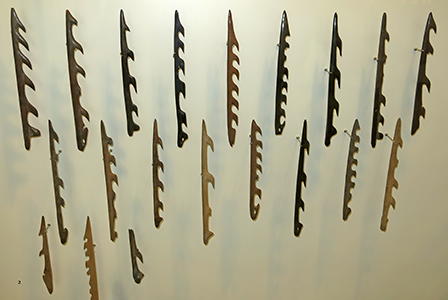
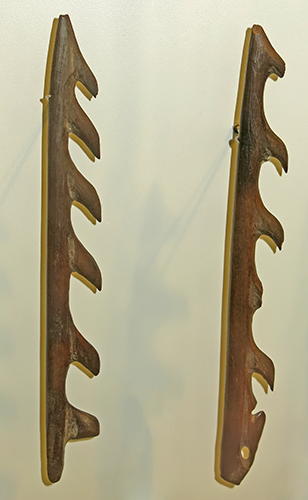
Harpoons made of elk or red deer bone/antler. Found during peat-digging in various bogs. Maglemose Culture, 10 700 - 8 500 BP.
Photo: Don Hitchcock 2014
Source and text: Apparently originals, Københavns (Copenhagen) Museum, National Museum of Denmark.
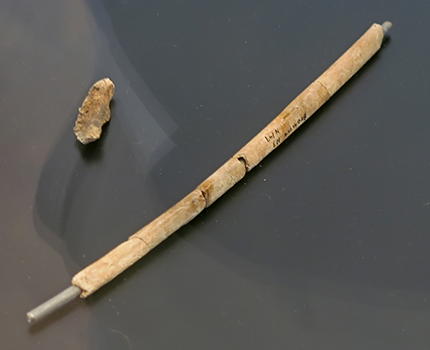
Pike bone (left) and swan bone on the right with a rod through it, from Bromme.
Bromme Culture, 13 000 BP.
Photo: Don Hitchcock 2014
Source and text: Apparently originals, Københavns (Copenhagen) Museum, National Museum of Denmark.
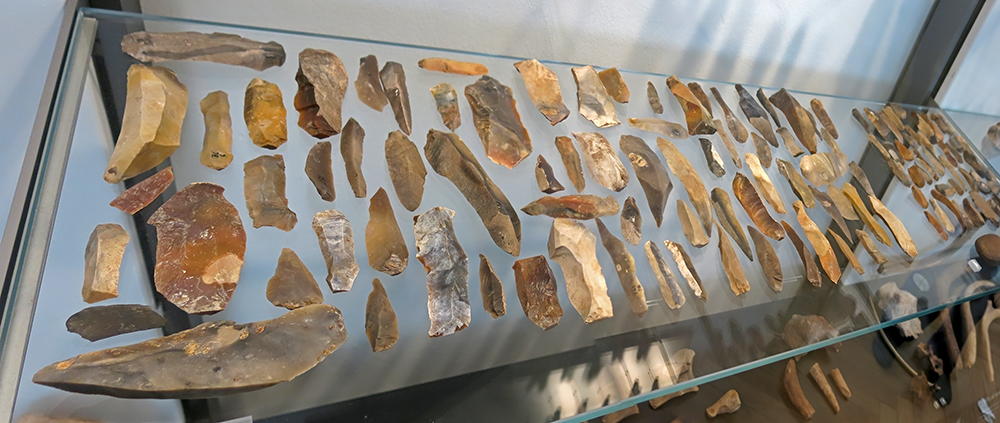
Tanged points, scrapers, burins, blades and cores from Bromme. Bromme Culture, 13 000 BP.
Photo: Don Hitchcock 2014
Source and text: Originals, Københavns (Copenhagen) Museum, National Museum of Denmark.
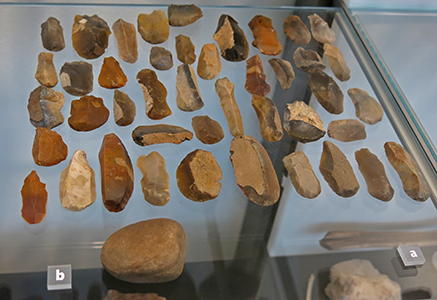
In front, left, labelled 'b', a hammer stone for knapping flint.
Behind, tanged points, scrapers, burins, blades and cores from Bromme.
Bromme Culture, 13 000 BP.
Photo: Don Hitchcock 2014
Source and text: Originals, Københavns (Copenhagen) Museum, National Museum of Denmark.
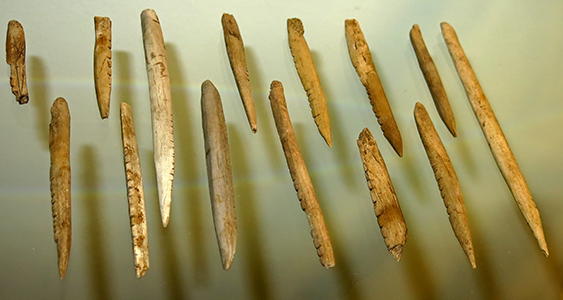
Fish spears of bone from an elk-hunting site at Skottemarke, Lolland.
Early Maglemose Culture, 10 700 BP.
Photo: Don Hitchcock 2014
Source and text: Originals, Københavns (Copenhagen) Museum, National Museum of Denmark.
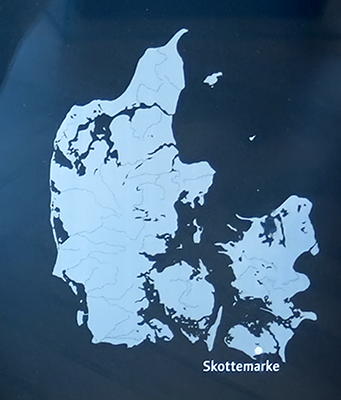
Map showing the position of Skottemarke.
Rephotography: Don Hitchcock 2014
Source and text: Display, Københavns (Copenhagen) Museum, National Museum of Denmark.
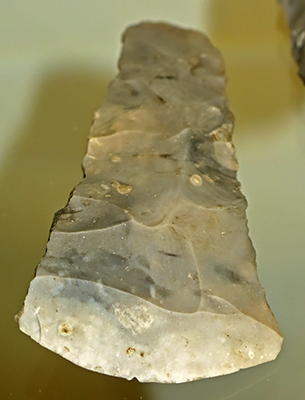

Flint axes from an elk-hunting site at Skottemarke, Lolland.
Early Maglemose Culture, 10 700 BP.
Photo: Don Hitchcock 2014
Source and text: Originals, Københavns (Copenhagen) Museum, National Museum of Denmark.
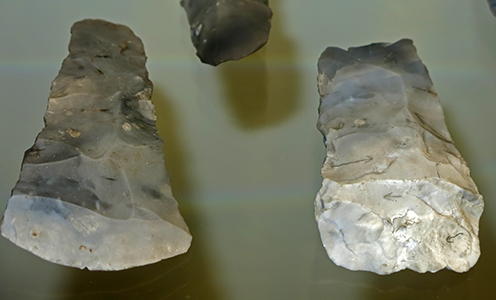
Flint axes from an elk-hunting site at Skottemarke, Lolland.
Early Maglemose Culture, 10 700 BP.
Photo: Don Hitchcock 2014
Source and text: Originals, Københavns (Copenhagen) Museum, National Museum of Denmark.
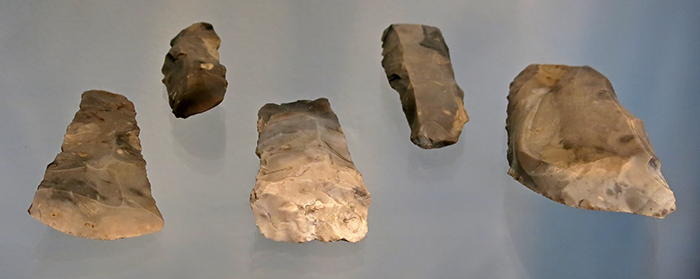
Flint axes from an elk-hunting site at Skottemarke, Lolland.
Early Maglemose Culture, 10 700 BP.
Photo: Don Hitchcock 2014
Source and text: Originals, Københavns (Copenhagen) Museum, National Museum of Denmark.
Flint tools from a reindeer hunter's camp at Solbjerg, Lolland.
Ahrensburg culture, 9 500 BP.
Photo: Don Hitchcock 2014
Source and text: Originals, Københavns (Copenhagen) Museum, National Museum of Denmark.
Flint tools from a reindeer hunter's camp at Solbjerg, Lolland.
Ahrensburg culture, 9 500 BP.
Photo: Don Hitchcock 2014
Source and text: Originals, Københavns (Copenhagen) Museum, National Museum of Denmark.
Flint tools from a reindeer hunter's camp at Solbjerg, Lolland.
Ahrensburg culture, 9 500 BP.
Photo: Don Hitchcock 2014
Source and text: Originals, Københavns (Copenhagen) Museum, National Museum of Denmark.
Closeup of a flint tool from a reindeer hunter's camp at Solbjerg, Lolland, as above.
Ahrensburg culture, 9 500 BP.
Photo: Don Hitchcock 2014
Source and text: Originals, Københavns (Copenhagen) Museum, National Museum of Denmark.
Closeup of some of the flint tools from a reindeer hunter's camp at Solbjerg, Lolland, as above.
Ahrensburg culture, 9 500 BP.
Photo: Don Hitchcock 2014
Source and text: Originals, Københavns (Copenhagen) Museum, National Museum of Denmark.
2b - Tools from a flint concentration of the Federmesser (penknife) culture.
Federmesser culture, 12 200 BP.
Photo: Don Hitchcock 2014
Source and text: Originals, Københavns (Copenhagen) Museum, National Museum of Denmark.
(left) 2b - Tools from a flint concentration of the Federmesser (penknife) culture.
(right) 2c - Tools from a flint concentration of the Hamburg culture.
Hamburg culture, 12 200 BP.
Photo: Don Hitchcock 2014
Source and text: Originals, Københavns (Copenhagen) Museum, National Museum of Denmark.
2c - Tools from a flint concentration of the Hamburg culture.
Hamburg culture, 12 200 BP.
Photo: Don Hitchcock 2014
Source and text: Originals, Københavns (Copenhagen) Museum, National Museum of Denmark.
2c - Tools from a flint concentration of the Hamburg culture.
Hamburg culture, 12 200 BP.
Photo: Don Hitchcock 2014
Source and text: Originals, Københavns (Copenhagen) Museum, National Museum of Denmark.
Magical amber animals
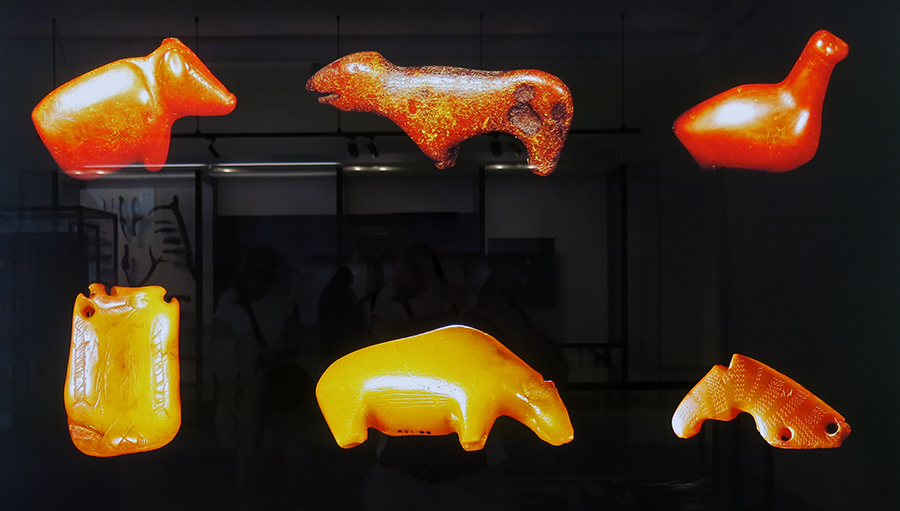
Many of the Mesolithic period’s artistic masterpieces have been found in Denmark. Among them are bears, a bird and an elk of amber. The figures are elegant and shaped in a way that is true to nature. The people who made them must have had a good knowledge of how a real bear looked. Like many other amber finds from the Stone Age, the animal figures have been found in bogs or on beaches. Therefore the amber pieces can be hard to date. In some cases the Stone Age people decorated their objects with refined designs or geometric art. Decorated amber artefacts can be dated by association with other objects, which the Mesolithic period is known for, most often bones.
Text above: en.natmus.dk
Photo: Don Hitchcock 2014
Source: Originals, Københavns (Copenhagen) Museum, National Museum of Denmark.
Amber bear.
Photo: Don Hitchcock 2014
Source: Originals, Københavns (Copenhagen) Museum, National Museum of Denmark.
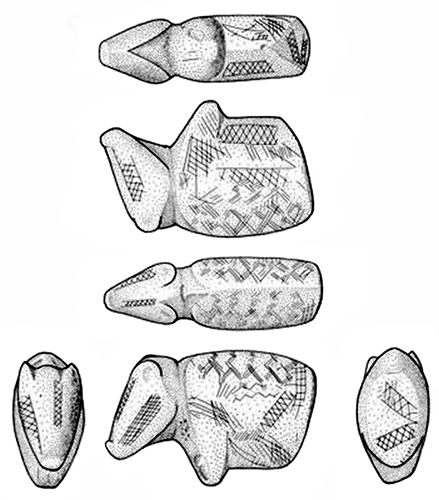
This amber bear from Resen Mose is carefully decorated.
Photo (above): Don Hitchcock 2014
Source: Original, Københavns (Copenhagen) Museum, National Museum of Denmark
Drawing (left): artist undisclosed, from en.natmus.dk
text: en.natmus.dk
Amber bird from Engesvang, and an elk (moose) head.
The elk head from Egemarke in Zealand originally had three holes drilled in it, but one has been broken out.
Photo: Don Hitchcock 2014
Source: Originals, Københavns (Copenhagen) Museum, National Museum of Denmark.
The famous amber elk head from Egemarke in Zealand is decorated in an 'Allerød-style', characterised by bands of closely aligned parallel zigzag lines.
Photo: Arnold Mikkelsen
Source: Petersen (2019)
Amber bear.
( This piece is of high artistic quality - Don )
Photo: Don Hitchcock 2014
Source: Originals, Københavns (Copenhagen) Museum, National Museum of Denmark.
Amber talisman, from Åmosen.
Pendants could be made of amber. The large drop-shaped pieces, that are most commonly found in Jutland, are especially showy. These have holes bored in them, so they can be worn on a string. However, it is not clear whether it was men or women who wore them, or perhaps both. Their purpose is also unclear. The golden pendants may have functioned as protective amulets, like other amulets from the Mesolithic period. Some of the amber jewellery is decorated with incised patterns, such as netting, or in a rare case stylised human figures.
( There may be anthropoid figures engraved on the obverse surface of this talisman. It was obviously important to the wearer, as there are three holes on the top margin which have all worn through, until the fourth, worn from use though still intact, was created. The reverse side shown on the right uses the iconic 'barbed line' technique - Don )
Photo (left, obverse): Don Hitchcock 2014
Photo (right, reverse): Arnold Mikkelsen, samlinger.natmus.dk/do/asset/9661
Source and text: Originals, Københavns (Copenhagen) Museum, National Museum of Denmark.
Amber talismans.
A close up of some of the amber pendants from Denmark which exhibit the engraving method and the barbed line technique. Perforations at the top, presumably made in order to hang the pendant, have broken.
Left: Amber pendant with ornamentation (A48088, 03.07.10, Sindalgård / Åmosen).
Centre: Amber pendant with ornamentation (A45806, 03.07.10, Mosegård)
Right: Amber pendant with ornamentation (uknown no., 03.03.06, Kongsted Mose)
Photo: Arnold Mikkelsen, samlinger.natmus.dk/do/asset/9661
Source and text: Originals, Københavns (Copenhagen) Museum, National Museum of Denmark.
Amber talismans.
A selection of amber pendants from Denmark. Some objects exhibit engraved lines, others demonstrate the drilling technique to produce lines of dots.
Photo: Arnold Mikkelsen, Nationalmuseet samlinger.natmus.dk/DO/9628.
Source and text: Milner, N. et al. (2016))
'Cherry' amber pendants on the left, mostly yellow ones on the right, and all with drilled patterns.
They are mainly from the Maglemose period, 10 000 BP - 9 000 BP
Photo: Don Hitchcock 2014
Source: Originals, Københavns (Copenhagen) Museum, National Museum of Denmark.
Amber pendants.
( Note that there seem to be multiple copies of the important and distinctive pendant on the right. Some that appear original must be excellent facsimiles. - Don )
Photo: Don Hitchcock 2014
Source: Originals, Københavns (Copenhagen) Museum, National Museum of Denmark.
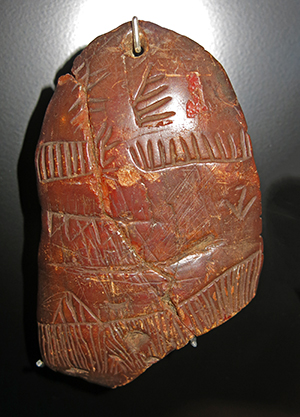
Amber pendant.
(
There are interesting patterns on this piece. The standard line with a fringe of 'barbs' attached is in evidence, certainly, at the base of the piece, but there is a triangle on this row of line plus barbs, almost like a steep hill, or a volcano. There is an asymmetrical design on the top middle, like part of a branch. Below that is a line with barbs, but they are much thicker than normally displayed. There is a grid on the left middle, and a curious 'arrow' shape on the right, with a bar added to one side of the shaft of the 'arrow' - Don )
Photo: Don Hitchcock 2014
Source: Originals, Københavns (Copenhagen) Museum, National Museum of Denmark.

Amber pendant.
( This amulet of 'cherry' amber has a repeated pattern of line plus barbs, as well as three vertical lines which have the form of twigs of a plant with leaflets arranged oppositely, but massed together like pine leaflets. There are two broken out suspension holes at the top of the amulet - Don )
Photo: Don Hitchcock 2014
Source: Originals, Københavns (Copenhagen) Museum, National Museum of Denmark.
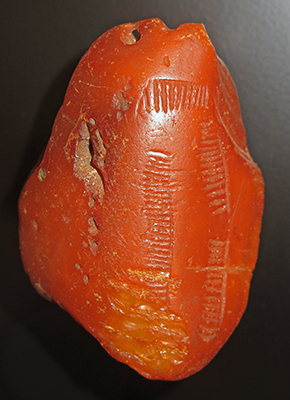
Amber pendant.
( This amulet of 'cherry' amber has a simple decoration of barbed lines - Don )
Photo: Don Hitchcock 2014
Source: Originals, Københavns (Copenhagen) Museum, National Museum of Denmark.

Amber pendant.
( This amulet of 'cherry' amber is like a sketchpad in some respects.
There are a few 'barbed lines', but there are also a large number of long shallow scratches on its face, as well as what seem to be marks made by tapping on the face causing small fractures rather than by drilling neat holes or cup marks - Don )
Photo: Don Hitchcock 2014
Source: Originals, Københavns (Copenhagen) Museum, National Museum of Denmark.
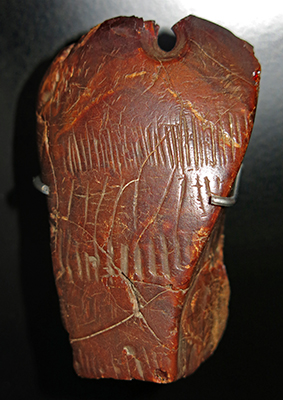
Amber pendant.
( This is another interesting amulet - there are a number of thin lines engraved at the top of the piece, but they are not of equal lengths, nor lined up at at least one end, as is usual.
Towards the bottom are some much thicker lines carved in a group, lined up in some sort of order.
But between these two are some purposefully engraved marks or signs, looking for all the world like characters from an alphabet. They have no obvious symmetry - Don )
Photo: Don Hitchcock 2014
Source: Originals, Københavns (Copenhagen) Museum, National Museum of Denmark.
The protracted end of the ice age
( note that the dates given here are only approximate, and different sources give slightly different dates for the various stages - Don )
Top left: The Baltic Ice Lake, 14 000 BP to 11 700 BP, was a large freshwater lake and predecessor to the Baltic Sea. It was created when the inland ice sheet gradually began to retreat to the north, and a freshwater reservoir was formed in the southern part of the Baltic Sea basin. The lake was dammed partly by the surrounding lands and partly by the inland Baltic Ice Sheet, was higher than the ocean, and had icebergs drifting on its surface.
Top right: The Yoldia Sea, 11 700 BP to 10 700 BP, dated by material from ancient sediments, shore lines, and from clay-varve chronology.
The Yoldia Sea is the name given by geologists to a variable brackish-water stage in the Baltic Sea basin that prevailed after the Baltic ice lake was drained to sea level. The name derives from the bivalve, Yoldia arctica, now known as Portlandia arctica, which requires cold saline water. Its presence indicates the middle phase of the Yoldia Sea, when saline water poured into the Baltic, before the acceleration of glacial melting.
Bottom left: The Ancylus Lake, 10 700 BP to 9 800 BP, which replaced the Yoldia Sea after the latter had been severed from its saline intake across a seaway along the Central Swedish lowland, roughly between Gothenburg and Stockholm. The cutoff was the result of isostatic rise, itself because of the removal by melting of the weight of several kilometres thickness of ice, being faster than the concurrent post-glacial sea level rise. In 1887 Henrik Munthe was the first geologist to draw the conclusion that the Baltic Sea must once have been a freshwater lake, after finding fossils of the fresh water snail Ancylus fluviatilis in sediments.
Bottom right: The Littorina Sea, 9 800 BP to 5 000 BP replaced the Ancylus lake when rising sea levels began to break through the Dana River valley. This transformation was gradual, and the salt-water that began to enter the lake resulted in episodic brackish water pulses. The proper end of the Ancylus Lake came however around 7 800 BP – 7 200 BP when the Øresund, or the Sound, the strait which forms the Danish–Swedish border, was completely breached by the sea, causing a massive inflow of salt-water. The Littorina Sea is named after the common periwinkle Littorina littorea, then a prevailing mollusc in the Baltic Sea, which indicates that the water was saline.
Source and text: http://www.dandebat.dk/eng-dk-historie5.htm
Additional text: Wikipedia, Wikivisually
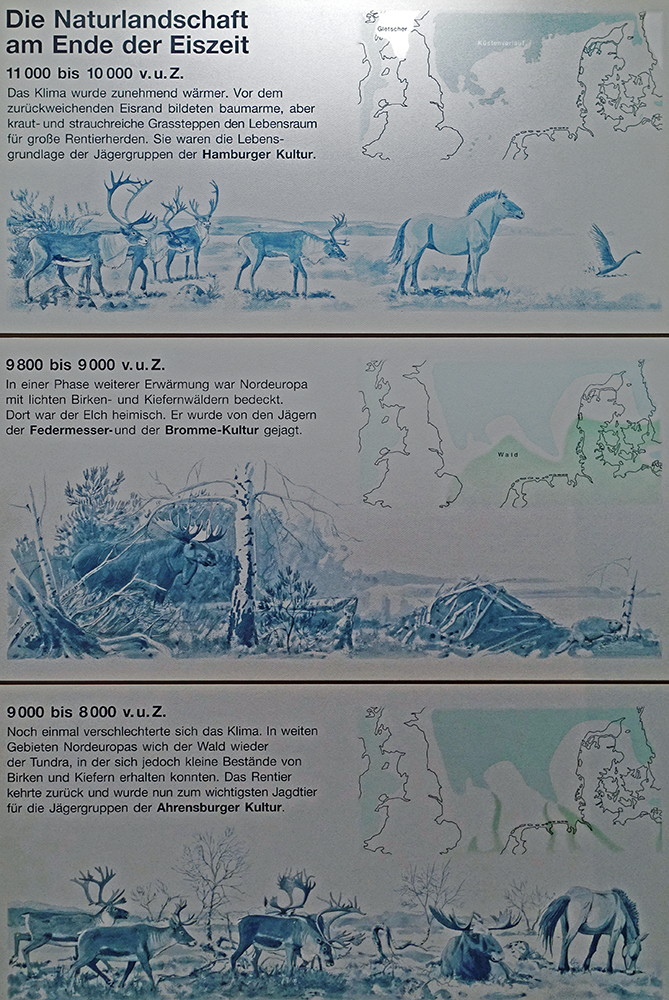
The natural landscape at the end of the ice age
Hamburg culture
13 000 BP to 12 000 BP
The climate became increasingly warm. In front of the receding ice edge, tree-poor, but herbaceous and shrubby grassy steppes formed the habitat for large reindeer and horse herds. They meant life for the hunter groups of the Hamburg culture.
Federmesser and Bromme cultures
11 800 BP to 11 000 BP
In a period of further warming, northern Europe was covered with sparse birch and pine forests.
Now the moose was at home, in forested areas where there was snow cover in the winter, and there were nearby lakes, bogs, swamps, streams and ponds. They were stalked by the hunters of the Federmesser and Bromme cultures.
Ahrensburg culture
11 000 BP to 10 000 BP
Once again the climate worsened with the onset of the Younger Dryas, the last cold snap of the Ice Age. In many areas of northern Europe, the forest retreated to the tundra, where small groups of birch and pine trees could be found. The reindeer returned and became the most important prey for the hunting groups of the Ahrensburg culture.
The Ahrensburg culture was a late Upper Palaeolithic nomadic hunter culture during the Younger Dryas, the last spell of cold at the end of the Weichsel glaciation resulting in deforestation and the formation of a tundra with bushy arctic white birch and rowan.
( Note that ages of events given in resources are often rubbery. The Younger Dryas is now given by many sources, (and thus the dates for the Ahrensburg culture) as 12 900 - 11 600 BP, as at 2024 - Don )
( The Federmesser (literally, feather knife) culture is named after a characteristic small knife, dubbed in English a penknife. Both terms refer to a small knife used to cut a pen from, typically, a goose quill. In common English usage it now means a small sharp knife which folds into its handle, kept in the pocket, sometimes called a pocket knife in fact, and used for minor tasks, though few users of the term now would be aware of its etymology.
The Bromme culture is named after a settlement at Bromme on western Zealand, and it is known from several settlements in Denmark and Schleswig-Holstein - Don )
Rephotography: Don Hitchcock 2018
Source and text: Museum für Archäologie Schloss Gottorf
Additional text: Wikipedia

The changes in average temperature, flora and fauna during the Late Glacial in Southern Scandinavia.
The Laacher See eruption occurred around 13 000 BP and acts as a useful chronostratigraphic marker for this time.
Photo and text: Riede et al. (2011)
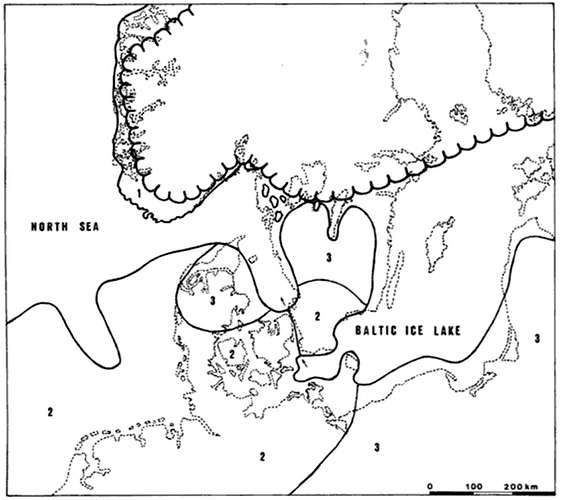
South Scandinavian land and sea configuration in Dryas III (ice margin at 10 000 BP)
1 - Tundra
2 - Park-Tundra with birch groves
3 - Sparse birch and pine forests
Readers may be interested in this map of the dying stages of the last ice age, when reindeer hunters moved north onto the Scandinavian peninsula following the herds, in the process learning how to follow them across the fiords, and to invent the skin boats and adaptations of the spear and harpoon hunting tool kit necessary for this process, which then allowed them access to a hitherto untapped biome of fish and marine mammals.
However the increasingly warmer and wetter conditions of the Holocene Climate Optimum (HCO) was a warm period that occurred in the interval roughly 9 000 BP - 5 000 BP years ago BP, with a thermal maximum around 8 000 BP.
This suited the development of significant numbers of moose (European elk), and this new food source was quickly exploited by the hunters when it became available. Note, however, that conditions were favourable for moose in some areas even as early as 10 700 BP when the Early Maglemose Culture, at Skottemarke, Lolland, certainly exploited moose.
This map shows the Baltic Ice Lake just before it joined with the North Sea at around 10 000 BP, and the Vegetation Zones which were extant at that time.
It should be noted that moose, European elk, prefer wet, boggy forests where they can find suitable forage. Standing or swimming in lakes and ponds, they feed on many kinds of aquatic plants. A moose eats an average of 20 kg of wet forage a day, but this amount increases to near 30 kg in the spring, and a whopping 60 kg daily in the autumn. Moose sometimes bend a sapling over so that they can nibble its tender upper leaves. In winter months, they rely more on their browse of woody plants that includes twigs, buds, and bark of willow, balsam, aspen, dogwood, birch, cherry, and virburnum.
Photo: Straus (1996)
Text: adapted from Wikipedia
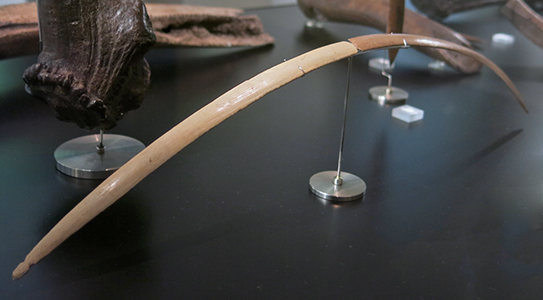
This 9 000 year old mouth bow from Mullerup, western Zealand, is the world’s oldest stringed instrument. The bow, which is made from a rib bone, is preserved. It has grooves for attaching a string, although the latter has not survived. The mouth bow is an ancient instrument. It consists of a flexible bow with a string stretched out over it. When the string is played the mouth cavity acts as a resonator.
Music was closely connected with magic, and the oldest musical instruments included the mouth bow, the drum, the flute, and the bullroarer.
Photo: Don Hitchcock 2014
Source: Originals, Københavns (Copenhagen) Museum, National Museum of Denmark.
Text: en.natmus.dk/
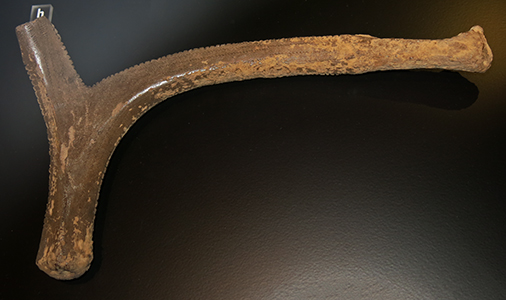
Drum hammer of elk antler, Vedbæk, 7 500 BP.
This decorated object may be compared to the drum hammers used by the shamans of the Sámi people. The shamans may have worn animal skin costumes during ceremonies, but these clothes are not preserved today.
( Note that the hammer has been carefully and symmetrically notched along much of its edge. This is probably so that it may be used as an idiophone, making a rhythm when stroked by another piece of antler or bone - Don )
Photo: Don Hitchcock 2014
Source: Originals, Københavns (Copenhagen) Museum, National Museum of Denmark.
Text: en.natmus.dk/
Possibly a dancing shaman ( and his spirit otherself? - Don ) on an axe of deer antler, Veksø, northern Zealand, 9 000 BP.
Many of the tools from the Mesolithic period were decorated with incised or bored motifs. A human figure has been incised into an axe made from deer antler from Bodal Mose. The man appears to be moving – perhaps he is a dancing shaman?
Axes of deer antler are probably battle axes that had a magical or ritual function. Often the motifs are abstract, but in the case of the axe from Bodal Mose there is no doubt that a human figure can be seen.
Photo: Don Hitchcock 2014
Source and text: Original, Københavns (Copenhagen) Museum, National Museum of Denmark.
Additional text: en.natmus.dk

The other side of the object has the familiar 'barbed lines' common on such decorated pieces of this time period.
Photo: Don Hitchcock 2014
Source: Original, Københavns (Copenhagen) Museum, National Museum of Denmark.
A shaman, very much elongated in stature.
(
In the right hand image we can see that he is standing opposite to an object which looks something of the size and shape of a large fish - or perhaps it is an article used by the shaman, such as a drum.
This shaman has been engraved on a piece of antler apparently shaped to act as a wedge or an axe, though the well worn hole in the shaft implies that it may have been used for straightening spear shafts.
The hole may have been to take a handle to make it an axe, but curiously it appears to be at an angle to the wedge, and the piece of antler is curved to one side, neither of which is ideal for an axe. - Don )
Many hunting peoples have shamans. They can go into a trance under the influence of drum music and rhythmic dancing. During the trance the soul leaves the shaman’s body and travels to ‘the other world’. Some Mesolithic objects from Denmark display incised figures which may represent shamans. This decorated elk ( moose ) antler from Vedbæk may be compared to the drum hammers used by the shamans of the Sámi people. The shamans may have worn animal skin costumes during ceremonies, but these clothes are not preserved today.
Photo: Don Hitchcock 2014
Source and text: Original, Københavns (Copenhagen) Museum, National Museum of Denmark.
Additional text: en.natmus.dk
Engraving of moose on a piece of moose antler.
( This engraving appears to show a female moose (or a male moose without antlers, in winter) being herded by a hunter into a trap bordered by quickly made 'zig zag' wooden fences (between poles in the ground (or existing trees) for stability). The Sámi peoples of northern scandinavia in historical times used similar methods to trap reindeer - Don )
Photo: Don Hitchcock 2014
Source: Københavns (Copenhagen) Museum, National Museum of Denmark.
Drawing artist: unrecorded
Source: en.natmus.dk
Awl.
This was identified as a dagger with a human figure, from Køge, 5 500 BC
Photo: Don Hitchcock 2014
Source: Københavns (Copenhagen) Museum, National Museum of Denmark.
Dancing pregnant women (?) on a bone club, from Sorø, Denmark.
Photo: Don Hitchcock 2014
Source: Original, Københavns (Copenhagen) Museum, National Museum of Denmark.
Text: en.natmus.dk/
Close up of the drawings on the bone club above.
Photo: Don Hitchcock 2014
Source: Original, Københavns (Copenhagen) Museum, National Museum of Denmark.

Bull-roarer of bone, Kongemosen, 8 000 BP.
This bull roarer was found at Kongemosen in western Zealand. It is a musical instrument which consists of a worked piece of a bone. The outline is a pointed oval, and a hole has been bored into one end, through which a piece of string could be threaded. Swinging it in the air produced a humming sound. As the object is unique in Denmark its function has also been frequently debated.
Could it have been a fish trap or a weaving tool? It is certainly believed that the hole was for attaching a string. This was tried when one of the archaeologists, inspired by a parallel find from northern Germany, swung the piece round in the air. Then something peculiar happened! The object produced a sound, which had not been heard for 8 000 years.
Photo: Don Hitchcock 2014
Source: Original, Københavns (Copenhagen) Museum, National Museum of Denmark.
Text: en.natmus.dk/

Identified as either a flaying knife or a netting needle, 8 000 BP - 6 000 BP.
( It could also be a bull-roarer - Don )
From the Kongemose or Ertebølle periods.
Photo: Don Hitchcock 2014
Source and text: Original, Københavns (Copenhagen) Museum, National Museum of Denmark.

Identified as a dagger, 8 000 BP - 6 000 BP.
( It could also be the business end of a harpoon. Note also the possibly anthropomorphic carved design - Don )
From the Kongemose or Ertebølle periods.
Photo: Don Hitchcock 2014
Source and text: Original, Københavns (Copenhagen) Museum, National Museum of Denmark.


Dagger, 8 000 BP - 6 000 BP.
( This appears to have been made with grooves to accept flint microblades. It would have been a formidable weapon at close quarters. The recipient of a well placed blow would have suffered massive shock (i.e. loss of blood) and would have died quickly.
The engraving on this piece is exquisite - Don )
From the Kongemose or Ertebølle periods.
Photo: Don Hitchcock 2014
Source and text: Original, Københavns (Copenhagen) Museum, National Museum of Denmark.
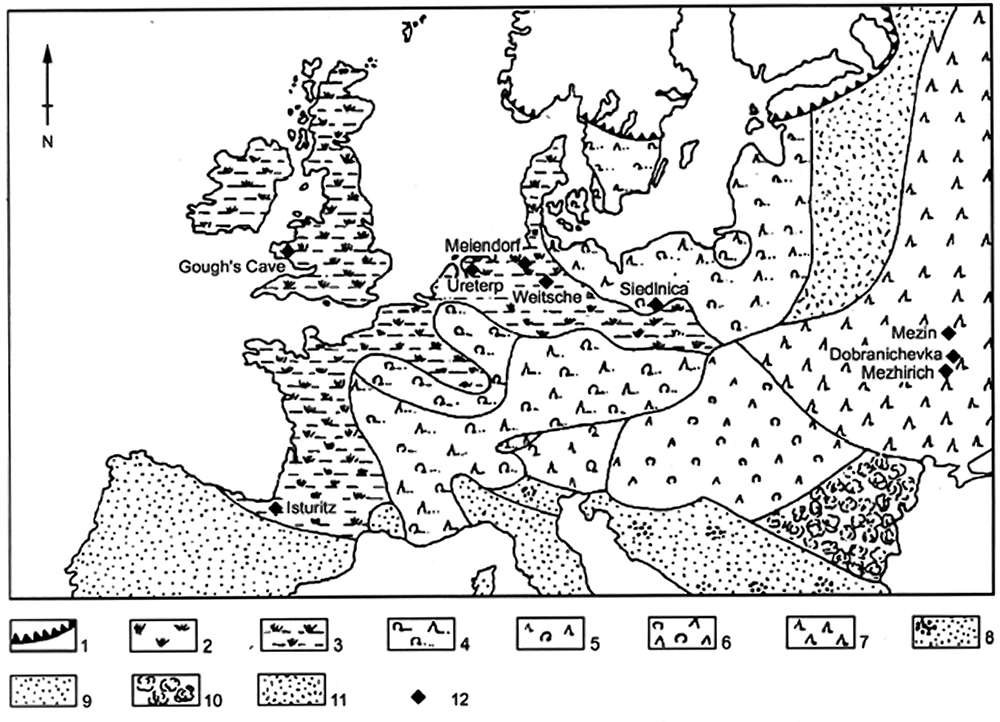
Map of the vegetation in Europe between 13 000 BP and 12 000 BP.
1 - Ice sheet
2 - Tundra
3 - Tundra 'xeric' variant (i.e. dry tundra)
4 - Birch-Pine forest
5 - Mixed forest
6 - Northern mixed conifer-deciduous forest
7 - Spruce dominated forest
8 - Steppe with Gramineae (now called Poaceae)
9 - Steppe (i.e. vast semi-arid grass-covered plain, as found in southeast Europe, Siberia, and central North America)
10 - Mixed-deciduous forest
11 - Mixed forest
12 - Sites with amber artefacts
Photo: Burdukeiwicz (1999)
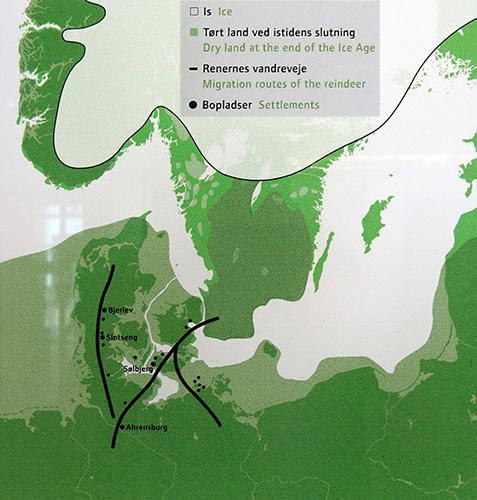
Hunting on the tundra
The Cro-Magnons came to Europe in a mild climatic period. Their settlements were scattered all over central Europe. Slowly the climate got colder. When Ice Age glaciers covered northern Europe around 20 000 BP, man had moved further south. In southern Europe the hunting culture survived the coldest period of the Ice Age. When the climate improved people quickly moved north. Wild horses and mammoths lived on the tundra, but it was mainly reindeer hunting that brought humans to Denmark 14 000 years ago. Here the hunters pitched their tents on windswept hills with a view of the migration routes of the reindeer.
Sea level was still low at the end of the Ice Age, ca 9 000 BP. The Baltic Sea was full of meltwater that ran into the sea via a river in the Øresund. The reindeer had fixed migration routes on the tundra, and the hunters' settlements lay along these routes.
Photo: Don Hitchcock 2014
Source and text: Københavns (Copenhagen) Museum, National Museum of Denmark
Hamburgian Culture
The Hamburg culture or Hamburgian (15 500 - 13 100 BP) was a Late Upper Paleolithic culture of reindeer hunters in northwestern Europe during the last part of the Weichsel Glaciation beginning during the Bölling Interstatial. Sites are found close to the ice caps of the time.The Hamburg Culture has been identified at many places, for example, the settlement at Meiendorf and Ahrensburg north of Hamburg, Germany. It is characterised by shouldered points and zinken tools, which were used as burins when working with horns. In later periods tanged Havelte-type points appear, sometimes described as most of all a northwestern phenomenon. Notwithstanding the spread over a large geographical area in which a homogeneous development is not to be expected, the definition of the Hamburgian as a technological complex of its own has not recently been questioned.
The culture spread from northern France to southern Scandinavia in the north and to Poland in the east. In the early 1980s, the first find from the culture in Scandinavia was excavated at Jels in Sønderjylland. Recently, new finds have been discovered at, for example, Finja in northern Skåne. The latest findings (2005) have shown that these people traveled far north along the Norwegian coast dryshod during the summer, since the sea level was 50m lower than today.
In northern Germany, camps with layers of detritus have been found. In the layers, there is a great deal of horn and bone, and it appears that the reindeer was an important prey. The distribution of the finds in the settlements show that the settlements were small and only inhabited by a small group of people. At a few settlements, archaeologists have discovered circles of stones, interpreted as weights for a tent covering.
Text above: Wikipedia
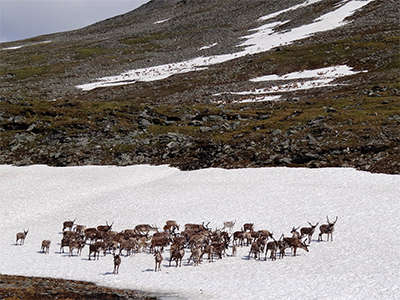
Numerous reindeer standing on patches of snow during summer to avoid blood-sucking mosquitoes and gadflies. Reindeer migrate to summer pastures not just for the grazing, but to avoid the worst of the insects.
Photo: Bjørn Christian Tørrissen
Permission: Creative Commons Attribution-Share Alike 3.0 Unported license
Text: adapted from Wikipedia
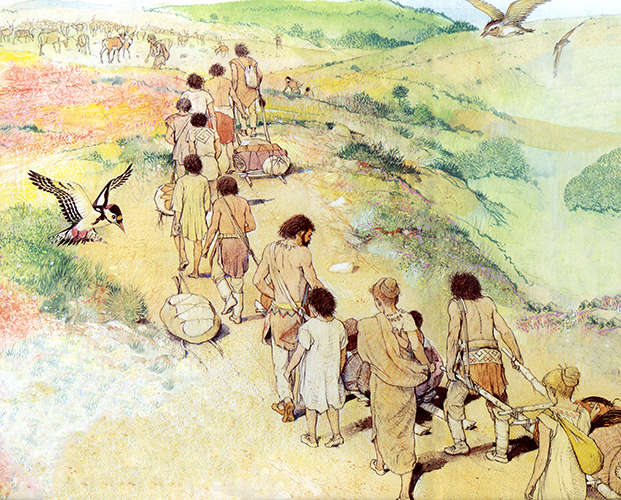
For weeks in the spring, the youngsters in the hunting band had been watching the reindeer in their winter, southern feeding grounds, and now the reindeer became restless, and began to move north to summer pastures. Their excited reports transformed the camp, which had been ready for this for a long time, and within a few hours everything was packed and in readiness for the long trek to the north, following the reindeer.
The reindeer mostly followed much the same path, but that was not always the case, and the life of the hunters was based around reindeer. Their main food was reindeer meat, though they varied it where possible, and their clothing, tools, weapons and tents were totally dependent on the harvest of reindeer.
The route taken by the huge herd of reindeer was easy to follow, but they never let the reindeer get too far ahead. The journey took a long time, but eventually they arrived in the north where the reindeer spread out on the tundra to graze, and the hunters set up camp near a good supply of water such as one of the glacial lakes that dotted the confused drainage of the tundra, and settled in for summer.
Photo and text: Adapted from Caselli (1985)
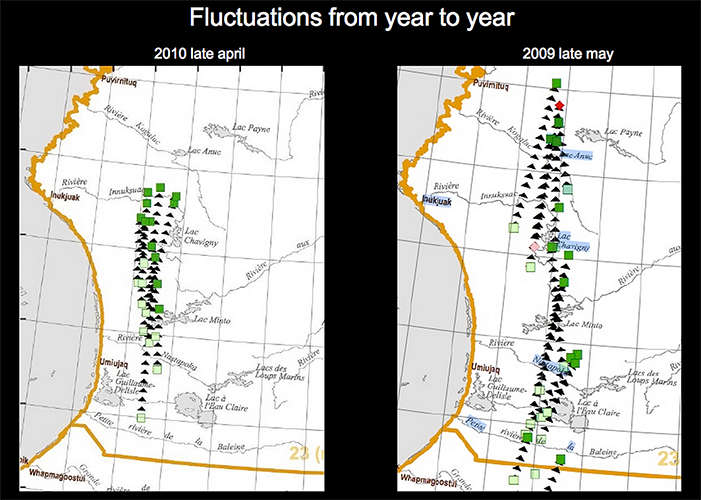
The reindeer hunters may have had to be flexible so far as meeting up with the migrations of the reindeer was concerned, depending on local conditions.
Migration paths were not necessarily fixed in stone, as these maps of the variation in caribou (reindeer) migrations on the shores of Hudson Bay, Canada, demonstrate.
Photo: Pedersen (2013)
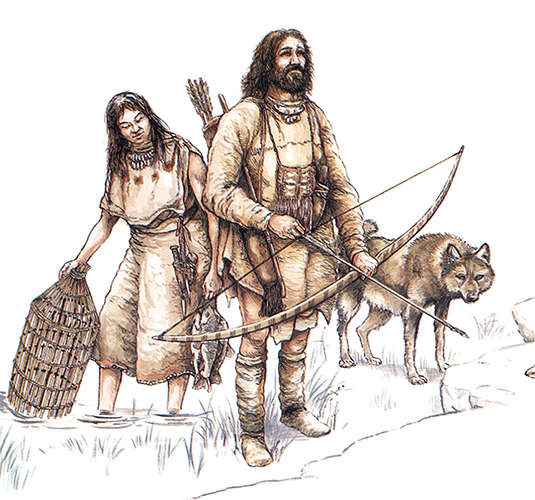
The people of the Hamburgian and Ahrensburg culture moved with the herds. Reindeer were their prime sustenance, for food, clothing, hides and weapons. This painting is more slanted to the Ahrensburg culture of Stellmoor, since the Hamburgian culture of Meiendorf mostly used spears thrown by spear throwers, and apparently did not have dogs, and the Ahrensburg mostly used bows and arrows, and had at least partly domesticated the dog. Both were summer camps to hunt reindeer, both were located by small lakes, and the two sites were only separated by 1300 metres.
Both had similar toolkit and cultural practices, including sacrificing the first prime reindeer of the season by sewing rocks in its abdominal cavity, and casting it into the lake. There was one such reindeer at the Hamburgian culture type site at Meiendorf, a site which was probably only used for one season, and more than thirty at the Ahrensburg culture at Stellmoor, a site which was used for a generation.
A reasonable hypothesis is that the Hamburgian culture typified by Meiendorf lasted from about 15 500 to 13 000 BP, and the Ahrensburg typified by Stellmoor existed from about 12 500 to 11 000 BP.
Photo: http://www.pkaj.dk/stellmoor_lokaliteten.asp
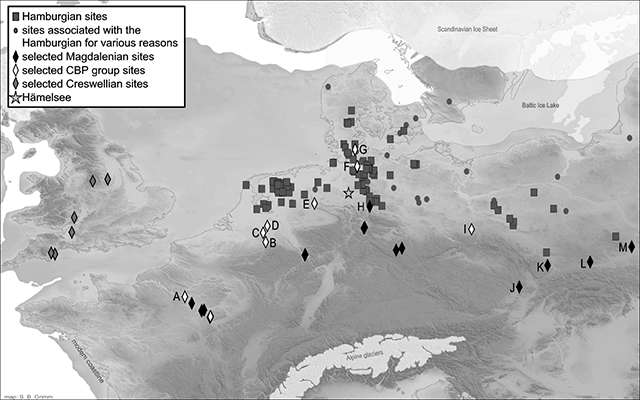
Distribution of the Hamburgian and sites associated with the Hamburgian in early Late glacial north-western Europe. Curve Backed Point (CBP) and Magdalenian sites labelled:
A – Le Closeau
B – Rekem
C – Budel
D - Milheeze-Hogeloop
E – Westerkappeln
F – Klein-Nordende
G - Alt Duvenstedt
H – Gadenstedt
I - Reichwalde,
J - Pekárna Cave
K - Dzierżysław 35
L - Maszycka Cave
M - Wilczyce
Photo and text: Grimm and Weber (2008)
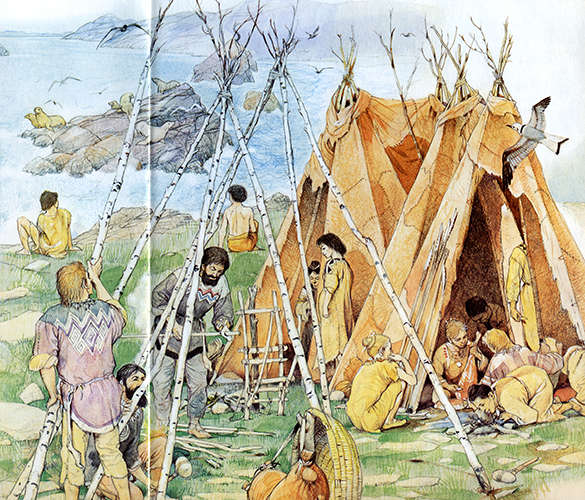
On arrival at the summer camp site, which was often the same site as previous years, if the reindeer kept to their traditional path, the hunters erected their tents. If it was in the nearly treeless tundra, near the eternal ice, as was normal, they would have had to have taken the poles for the tents with them, perhaps using them lashed together and dragged behind the trudging men, doing double duty in holding their heavy loads of supplies for the journey, as well as clothes, weapons and tools. When they had served this purpose, they were reused for tent poles.
The camp site was always near a supply of fresh water, and in the confused drainage of the tundra, this was always available in the form of lakes which were ice free in the summer, and which provided a convenient place ( human nature has not changed much, after all! ) to toss all their defleshed bones, unwanted antlers, broken tools, and other rubbish, keeping the campsite itself clean and wholesome - a godsend for archaeologists many thousands of years later.
The first task on arrival was to make a fire, achieved by striking flint on a piece of pyrites, or marcasite, with the resultant sparks falling onto finely pounded willow bark, dried moss, or a fungus such as Fomes fomentarius. The embers thus created were then quickly blown into a fire with fine tinder, then larger diameter wood was added to get the campfire burning well.
Even in the tundra small trees sometimes grow in sheltered positions, but fuel would always have been a problem in these areas. Bone will burn, especially if it is old, dry bone, but it is not an ideal fuel, and is best used in conjunction with whatever wood can be scavenged (Äikäs et al., 2010).
This beautiful art work created by Giovanni Caselli shows them, however, camped beside the sea. Out of sight but close at hand would have been a convenient brook for fresh water.
Photo and text: Adapted from Caselli (1985)
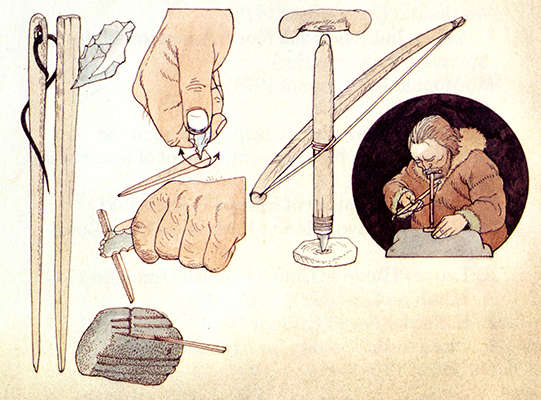
Drills were used as hand held tools and also hafted onto a handle to make them easier to use. Fine drills at the limit of the technology were needed to make holes in bone or antler needles to make the sewing of clothes easier. After the needles were created by scoring antler, the needles had a hole drilled in them, and were then fined down and rounded in grooves on pebbles of sandstone.
Photo: Caselli (1985)
The Settling of Finland after the Ice Age
The resettlement of Northern Europe after the last Ice Age.
The Trek Northward
With the warming in climate as the ice age ended, the Scandinavian Ice Sheet began to melt and recede. It is thought that very early ancestors of the Saami people, part of the larger
Ahrensburg archaeological culture, had been residing in what may be called the Iberian Refuge in France and Spain. This early ancestral group subsequently traveled north along the ice-free coast of Norway and settled in northern Norway, Sweden, Finland, and the Kola Peninsula of Russia.
The newly-arrived settlers formed what is termed the Komsa culture. They were likely isolated in northern Fennoscandia for several thousand years, their only contact being with other Arctic cultures.
In the east, the site of the Ukrainian Refuge, the beginning of the retreat of the Scandinavian Ice Sheet led to the progressive collapse of the hunting and gathering economy of the southern Russian Plain and the disintegration of the Upper Palaeolithic network of settlements. In about 13 000 BP hunter-gathering peoples, many of whom would later be identified as Finno-Ugrians, started moving out of the Ukrainian refuge to the areas that were newly freed up in the Northern and Northeast European Plain.
The ice border retreated slowly, at a mean rate of only about a kilometre per year, or about 50 kilometres during an average human lifespan of the time. About 2 500 years were required for the ice sheet to retreat as far as the borders of what is now Finland, where the first settlement sites date to about 10 500 BP.
Nunez (1987) believes that during this time the populations moved in what can be called a ‘jumping’ manner. A band would more or less permanently settle in a location, and after a number of generations a group would break away to move to new land that had been exposed by the retreating glacier, where hunting, fishing and gathering might be better.
Most of those who began streaming from the Ukrainian refuge were members of what is called the Swiderian culture, what is considered an 'archaeological culture'. That is, it is defined primarily in terms of characteristics such as sharing of language and similarities in artefact toolkits of implements and hunting methods, rather than in the usual sense of a culture as a cohesive entity. However, at the same time, there were a number of distinct cultures — in the familiar sense of the term — among the Swiderians and they might have foreshadowed the later various Finno-Ugric and Samoyed peoples.
Although the Swiderians maintained their separate cultural traditions, each speaking a different dialect of Proto-Uralic, they regularly interacted with each other — economically and socially — over the time of their two and a half millennium migration. In this way they formed what Dolukhanov (1996) calls 'a single socio-cultural exchange network'. This network was subsequently kept active for millennia in the de-glaciated areas, including the area of Finland.
Photo and text: www.spiritboat.ca
The Early Mesolithic 10 000 BP - 8 500 BP
The oldest evidence of human activity in Finland dates from around 10 000 varve years BP, after the time of the final drainage of the Baltic Ice Lake, circa 11 700 BP.
The Baltic Ice Lake is a name given by geologists to a freshwater lake that evolved in the Baltic Sea basin as glaciers retreated from that region at the end of the last ice age. The lake existed between 14 000 BP and 11 700 BP.
The Baltic Ice Lake is one of a number of water stages that eventually resulted in the modern Baltic Sea. After the Baltic Ice Lake came the Yoldia Sea (11 700 BP – 10 700 BP), the Ancylus Lake (10 700 BP – 9 800 BP), the Littorina Sea (9 800 BP – 5 000 BP) and finally the Baltic Sea (5 000 BP – present day).
The climate was dry and gradually becoming warmer. Finland's forests teemed with elk, bear and beaver, and there were large fish and seal stocks. Fowling was also very important. The archaeologicial record shows that the first settlers came from the east and the south. The main contacts were with the Mesolithic Kunda culture in Estonia. Even the oldest archaeological finds show that people lived here throughout the year.
By around 8 500 BP the whole of Finland was covered with pine forests, though broad leaved species began to spread at around the same time. Optimum climatic conditions followed in the Comb Ware period, corresponding to present-day temperatures in Central Europe. The climate in this region became colder and more humid at around 2 000 BP, after which spruce began to spread throughout Finland.
Text above: adapted from posters at The National Museum of Finland, Helsinki and Wikipedia
Elk’s Head of Huittinen
In the Stone Age, the elk (or moose) was an important animal that was depicted in both rock art paintings and objects. Objects decorated with elks’ heads had a special significance for people of the Stone Age. One of the most famous animal head weapons found in Finland is the Elk’s Head of Huittinen, which dates back to the Mesolithic Stone Age.
The elk’s head was found in a Stone Age settlement in Palojoki, Huittinen. Based on the radiocarbon dating of a hearth, the settlement dates back to approximately 8 100 BP (cal). The artfully carved object was probably modelled after a killed young elk about one year old. It is made of soapstone, which is soft and easy to work on, and has been carefully finished by grinding. The sculpture has a hole for fitting a handle, so it may possibly have been used as a staff or club. However, due to the soft stone of which it is made, the object was not suitable for use as a weapon or tool, so it was probably a valuable status item.
Catalog: KM6292:1
Photo: Ilari Järvinen, Helsinki / CC BY 4.0
Proximate source and text: www.kansallismuseo.fi
Elk or Moose head in wood.
( This wooden head may have been affixed to the prow of a boat, since there is a hole in the neck, and a deep notch just behind the head which, taken together, would have fastened it securely in place - Don )
Photo: Vladimir Gorodniansky 2024
Source: Original, National Museum of Finland, Helsinki
Map of Finland showing some early archaeological sites, after the collapse of the Baltic Ice Lake when the approximate modern coastline appeared, circa 11 700 BP.
( though the emergent coastline was later significantly altered over thousands of years because of isostatic uplift and changes in sea level - Don )
1. Antrea Korpilahti 9 320 ± 210 BP
2. Suomussalmi Vanha Kirkkosaari 8 950 ± 120 BP
3. Heinola Viikinainen 8 840 ± 90 BP
4. Inari Saamen museo 8 760 ± 75 BP
5. Hyrynsalmi Koppeloniemi 8 440 ± 130 BP
6. Enontekio Myllyjarama 8 320 ± 110 BP
7. Kajaani Akalanniemi 8 150 ± 110 BP
8. Sodankyla Autiokentta 7 930 ± 110 BP
9. Enontekio Proksin kentta 7 900 ± 110 BP
10. Enontekio Museotontti 7 880 ± 140 BP
11. Vantaa Jonsas 7 870 ± 120 BP
12. Rovaniemi Lehtojarvi 7 740 ± 170 BP
13. No Data
Source: Poster, The National Museum of Finland, Helsinki
Rephotography: Courtesy Vladimir Gorodniansky 2024
Seal Hunters and Fishers
The Suomusjärvi Culture
8 500 - 6 200
Around 9 000 years ago, the Baltic formed a link with the North Sea, creating the Littorina Sea. The continually warming maritime climate was humid.
Settlements, now in all parts of Finland, were chosen at shore locations according to the needs of fishing and hunting.
The Stone Age people were mobile, following game according to the seasons, and mainly hunting elk (moose), ringed seal and beaver. Fishing and fowling were also important means of subsistence. Dogs were the only domestic animals.
This wooden idol from Pohjankuru. Southern Finland, dates from circa 5 000 BP and is the oldest known portrait of an inhabitant of Finland.
Source and text: Original, The National Museum of Finland, Helsinki
Rephotography: Courtesy Vladimir Gorodniansky 2024
Stone Age Tools
Stone Age tools and implements have been named according to their most probable use. But many of them could have served different functions.
Axes and adzes were mainly woodworking tools. Most axes lacked holes for the haft. No Stone Age axe handles or hafts have been found in Finland, but there are corresponding hafted axes from Denmark. The adzes differ mainly in size from the axes, and could have been used similarly.
Small scrapers for preparing hides and smoothing wooden objects were also fitted with handles. Small adzes with curved blades were also used for scraping hides.
Flint Scrapers.
Source and text: Original, The National Museum of Finland, Helsinki
Rephotography: Courtesy Vladimir Gorodniansky 2024
Burin.
( Note that this burin is the same shape as the Parrot Beak burins of the Magdalenian, but appears to have been carefully polished, removing the knapping scars - Don )
Source and text: Original, The National Museum of Finland, Helsinki
Rephotography: Courtesy Vladimir Gorodniansky 2024
Flint Scrapers.
Source and text: Original, The National Museum of Finland, Helsinki
Rephotography: Courtesy Vladimir Gorodniansky 2024
Even Bladed Adzes.
Source and text: Original, The National Museum of Finland, Helsinki
Rephotography: Courtesy Vladimir Gorodniansky 2024
Narrow Adzes.
Source and text: Original, The National Museum of Finland, Helsinki
Rephotography: Courtesy Vladimir Gorodniansky 2024
Gouges.
Source and text: Original, The National Museum of Finland, Helsinki
Rephotography: Courtesy Vladimir Gorodniansky 2024
Double Bladed Adze.
Source and text: Original, The National Museum of Finland, Helsinki
Rephotography: Courtesy Vladimir Gorodniansky 2024
Maple felled with a stone axe in 1994, shown with two axes, the one on the right not yet finished.
( I have cut down a lot of trees with a bow saw and chain saw over the last fifty years, and I feel a better technique would be to first cut a groove all the way round with the stone axe, then come from each side, the first cut deeper than the second, and allow the weight of the tree to break the 'hinge' so left. For a tree of this small diameter, it should be possible to simply push from the side of the shallower second cut, to topple the tree - Don )
Source and text: Original, The National Museum of Finland, Helsinki
Rephotography: Courtesy Vladimir Gorodniansky 2024
Finds from dwelling sites usually consist of quartz artefacts, flakes, and debitage, stone adzes and axes, spear heads of slate, and burnt bone. Skilfully made objects of Onega green slate point to contacts with neighbouring areas. Flint was also imported from the east. The craft of pottery was not yet known. Finds from Eastern Finland differ from the material from the rest of the country, having closer connections with the cultural zone of East Karelia.
Mace head.
( Note the decorations painstakingly applied to this artefact and the ones immediately below on this page - Don )
Source and text: Original, The National Museum of Finland, Helsinki
Rephotography: Courtesy Vladimir Gorodniansky 2024
Mace head.
( Although relatively small, this mace would have created an immediately fatal wound if swung at the side of the skull of an adversary - Don )
Source and text: Original, The National Museum of Finland, Helsinki
Rephotography: Courtesy Vladimir Gorodniansky 2024
Two large and heavy mace heads.
( With long handles, either of these maces would be a devastating weapon in the hand of a strong and skilful warrior - Don )
Source and text: Original, The National Museum of Finland, Helsinki
Rephotography: Courtesy Vladimir Gorodniansky 2024
This has been identified as an antler artefact for removing snow and ice from furs.
( The long winter nights in the area would have allowed plenty of free time to complete this elaborate decoration - Don )
Gray (2009) notes that most hunter-gatherers, wherever they have been studied, live in bands of about 20 to 50 people each, counting children as well as adults. Each band moves as needed to follow the available game and edible plants. At each campsite to which they move, each family builds, from natural materials, a small, temporary hut, the construction of which usually takes just a few hours.
Hunter-gatherers typically devote about 20 hours per week to hunting or food gathering and another 10 to 20 hours to chores at the campsite, such as food processing and making or mending tools, much less time than most 21st century workers spend on making a living and completing household chores.
Source and text: Original, The National Museum of Finland, Helsinki
Rephotography: Courtesy Vladimir Gorodniansky 2024
Leaf shaped points.
Source and text: Original, The National Museum of Finland, Helsinki
Rephotography: Courtesy Vladimir Gorodniansky 2024
Curved backed gouges.
Source and text: Original, The National Museum of Finland, Helsinki
Rephotography: Courtesy Vladimir Gorodniansky 2024
Perforated stone artefacts and a globular mace.
Source and text: Original, The National Museum of Finland, Helsinki
Rephotography: Courtesy Vladimir Gorodniansky 2024
Red-ochre graves
Richly furnished Red-ochre graves
Red-ochre graves are known from Mesolithic (10 000 BP - 6 000 BP) and Comb Ware (6 200 BP - 4 000 BP) sites. These graves often contain large numbers of grave goods, usually flint points and personal ornaments of amber and slate. Artefacts and the size of the grave pits show that men, women, and children alike were buried. In many cases, the grave goods were part of a considerable amount of property.
Source and text: Poster, The National Museum of Finland, Helsinki
Rephotography: Courtesy Vladimir Gorodniansky 2024
These are grave goods from red ochre graves. Included are slate circles, probably arm ornaments, as well as flint tools and what may be pierced amber personal ornaments.
Although the prehistoric economy required self-sufficiency, systems of exchange emerged at an early stage between different areas. Slate from Northern Finland and East-Finnish steatite spread into all parts of the country. Flint was obtained from Russia and Southern Scandinavia. Adzes of green slate were imported from the Lake Onega region, and red-slate artefacts came from Northern Scandinavia.
The presence of objects from foreign lands does not always mean direct contact with those lands, and could have been passed on through trade with intermediaries. Trade and exchange were most active in the Comb Ware period, during which luxury ornaments of amber were imported from the southern shores of the Baltic. The furs of the north were probably always popular as trade goods in the south. Other articles of exchange may have been dried fish and seal blubber.
Source and text: Originals, The National Museum of Finland, Helsinki
Rephotography: Courtesy Vladimir Gorodniansky 2024
Additional text: Don Hitchcock
These are grave goods from red ochre graves, including pierced amber personal ornaments and flint tools.
Source: Originals, The National Museum of Finland, Helsinki
Rephotography: Courtesy Vladimir Gorodniansky 2024
Text: Don Hitchcock
This artist's impression depicts what the child buried in Majoonsuo might have looked like in life. A dog or wolf might have been laid at the child's feet. (Tom Björklund)
Stone Age child's grave site discovered in Finland
The burial site of a young child who lived 8 000 years ago, in the Mesolithic Period, has been discovered in Eastern Finland, providing a rare glimpse into how Stone Age humans treated their deceased.
The Majoonsuo grave first drew the attention of researchers in 1992 in the municipality of Outokumpu when bright red ochre, a clay rich in iron, was spotted on the surface of a new service trail in the forest. Red ochre has been associated with rock art as well as ornamentation and burials.
The Finnish Heritage Agency began excavating the spot in 2018 due to concerns over erosion and motor traffic.
Bright red ochre marked the spot of the grave, uncovered on a service road in a forest in Eastern Finland.
Little was found in the grave, but the surrounding soil revealed its secrets in a recent microscopic analysis published in September in the journal PLOS One.
Finland's Stone Age societies buried their dead in pits in the ground. The soil is so acidic in Finland that little remains preserved after thousands of years, which means traces of archaeological evidence are extremely rare.
The teeth of a child were found in the grave, as well as fragments of bird feathers, plant fibres and canine hair strands after an analysis using a painstaking protocol to uncover the microscopic evidence.
Together, these clues paint a portrait of the deceased.
Researchers determined that the teeth belonged to a child between 3 and 10 years old. Two quartz arrowheads and two other quartz objects, thought to be grave goods, were also recovered.
Source and text: Kirkinen (2022), www.9news.com.au
In addition to pottery (1), top left, the main difference with regard to the Comb Ware Period and the Mesolithic period preceding it, was the use of flint for making microliths, spearheads, knives (2), arrowheads (3) and scrapers (4).
Most of the flint (5) is of eastern origin, although artefacts of western flint have also been found. Various axes and adzes (6) were the most common stone artefacts. Mace heads with shaft holes (7) remained in use. Hides were shaped with knives made from slate (8), and small adzes with curved and level blades were used for making artefacts of wood and bone. Round stone discs (10) which appear in almost all periods of Finnish prehistory, are of unknown function.
Pendants and rings of slate (11) were domestic imitations of amber ornaments. Resin (12) may have been Stone Age 'chewing gum', but could also have been used as a glue or sealant. The miniature artefacts (13) such as even-bladed adzes, gouges, and the arrowhead and ceramic cups could have been children's toys. On the floor a whetstone (14), a pick (15), a gouge (16) and cradle rocker shaped picks (17).
Source and text: Originals, The National Museum of Finland, Helsinki
Rephotography: Courtesy Vladimir Gorodniansky 2024
Various axes and adzes (6) were the most common stone artefacts of the Comb Ware Period.
Source and text: Originals, The National Museum of Finland, Helsinki
Rephotography: Courtesy Vladimir Gorodniansky 2024
During the Comb Ware Period flint was used for making microliths, spearheads, knives (2), and arrowheads (3) at the rear of this shelf.
Pendants and rings of slate (11) at the front of the shelf were domestic imitations of amber ornaments.
Source and text: Originals, The National Museum of Finland, Helsinki
Rephotography: Courtesy Vladimir Gorodniansky 2024
During the Comb Ware Period mace heads with shaft holes (7) remained in use.
Source and text: Originals, The National Museum of Finland, Helsinki
Rephotography: Courtesy Vladimir Gorodniansky 2024
Features of decoration place Comb Ware Pottery into three main groups:
• Early Comb Ware (6 200 BP- 5 300 BP)
• Typical Comb Ware (5 300 - 4 800 BP)
• Late Comb Ware (4 800 BP - 4 000 BP)
The term Comb Ware comes from an ornamental detail resembling the mark of a comb made on the walls of vessels with round and pointed bases.
The vessels were fired at around 400°C on an open fire. The pits of the ornament may originally have been made to aid this process. In Early Comb Ware the pits were impressed into the completed decoration, while in the later Typical Comb Ware stage they formed a distinct part of the ornamental pattern, and were not just an afterthought. In making the pits, the vessel had to be supported by hand from within, which often left fingerprints on the inside surface.
Pot above: Early Comb Ware, identified as such by the observation that the pits
were added after the initial comb decoration, and are not an integral part of the decoration.
Potters in this region did not make their ceramic objects from pure clay. They tempered it with sand, crushed quartz or feldspar, burnt bone and other inclusions. The amount and type of temper varied through the ages. The potters of the Late Comb Ware period mixed their clays with crushed limestone and organic materials such as shells, feathers, and parts of plants.
Since the limestone has dissolved and the organic inclusions disappeared during the firing of the pots, the ware is now highly porous. In some cases temper led to completely new types of pottery, as in asbestos-tempered ceramics.
The Comb Ware pots were made by coiling. Grooved and tongued bands of clay 4 to 6 cm wide were joined to each other and the seam or join was smoothed over. The pots were decorated before the clay dried, and sometimes traces of ornament are found in the joins.
Coil technique was also used in asbestos-tempered ceramics and Corded Ware. Small vessels were shaped from a single piece of clay.
A cracked pot did not necessarily have to be discarded. Holes could be drilled and the crack could be sewn with sinew and sealed with birch resin or similar material that left a dark area around the fissure. These repairs were durable, for only rarely did the sam part of the pot break again.
The craft of making clay pots became known in Finland without any preceding changes in material culture, means of livelihood, or social organisation. It appears to have been a cultural loan that did not require new settlers.
Source and text: Original, The National Museum of Finland, Helsinki
Rephotography: Courtesy Vladimir Gorodniansky 2024
These are examples (1) of Early Comb Ware, not particularly well made, and with the pits impressed into the completed comb decoration while the clay was still soft.
At lower right, the resin (12) may have been Stone Age 'chewing gum', but could also have been used as a glue or sealant.
Source: Original, The National Museum of Finland, Helsinki
Rephotography: Courtesy Vladimir Gorodniansky 2024
Text: Don Hitchcock
This appears to be an example of the later Typical Comb Ware, since the pits
form a distinct part of the ornamental pattern.
Note also that the Curators at the museum have carefully repaired the pot, obviously found in pieces. The modern repairs, while wholly fitting with the general look of the pot, and coloured so as not to draw attention to the repair, have nevertheless been done so that scholars can easily tell which is the original, and which is the repair, which is standard best practice in such curation.
Source: Original, The National Museum of Finland, Helsinki
Rephotography: Courtesy Vladimir Gorodniansky 2024
Text: Don Hitchcock
Two more examples of Typical Comb Ware.
Source: Original, The National Museum of Finland, Helsinki
Rephotography: Courtesy Vladimir Gorodniansky 2024
Text: Don Hitchcock
Corded Ware / Battle Axe Culture
The graves of the Corded Ware / Battle Axe Culture differ from those of the Comb Ware period. The deceased was now laid in an oval or rectangular pit, sometimes containing a timber framework. The body was on its side with the knees bent and was sometimes covered with furs or birch bark. Red ochre was not used. Grave goods included every day objects such as pots, working axes and boat axes.
A burial rite including grave goods points to a belief in the afterlife. The religion of the Corded Ware people was in some way connected with their means of livelihood.
Corded Ware (or Battle-Axe) Culture spread to Finland circa 5 200 cal BP. It was soon established in the South West part of the country and a sharp cultural border developed against northeastern hunting and fishing communities. However, Corded Ware influence leaked northwards along coastal Ostrobothnia and also influence from part of the Swedish Battle-Axe culture were felt in the north.
Source: Original, The National Museum of Finland, Helsinki
Text: Carpelan (2004)
Rephotography: Courtesy Vladimir Gorodniansky 2024
In the Battle Axe culture, the deceased were usually placed in a single flat grave with no barrow. Graves were typically oriented north-south, with the body in a flexed position facing towards the east. Men were placed on their left sides, while women were placed on their right sides. As regards both objects and placement, the grave goods are quite standardised. Axes of flint are found in both male and female burials. Battle axes are placed, with males, close to the head. These battle axes appear to have been status symbols, and it is from them that the culture is named. About 3000 battle axes have been found, in sites distributed over all of Scandinavia, but they are sparse in Norrland and northern Norway.
The polished flint axes of the Battle Axe culture and the Pitted Ware culture trace a common origin in southwest Scania and Denmark. Corded Ware ceramics were also common grave goods in Battle Axe burials. They were usually placed near the head or feet. Other grave goods include arrowheads, weapons of antler, amber beads, and polished flint axes and chisels. Faunal remains from burials include red deer, sheep, and goat.
A new aspect was given to the Battle Axe culture in 1993, when a death house in Turinge, in Södermanland was excavated. Along the once heavily timbered walls were found the remains of about twenty clay vessels, six work axes and a battle axe, which all came from the last period of the culture. There were also the cremated remains of at least six people. It is the earliest find of cremation in Scandinavia and it shows close contacts with Central Europe.
Text above: Wikipedia
Perforated Battle Axes.
The Battle-Axe cultures of Europe are assumed to have spread rapidly by conquring new areas. The distinctive artefact of this culture is the boat- or battle-axe, of which some 900 have been found in Finland. Some of these objects have raised bands imitating the casting seams of copper axes.
The precise function of the boat-axes remains unsolved. They may have been emblems of status or ritual objects. The boat-axes could also have been weapons of combat.
Source and text: Original, The National Museum of Finland, Helsinki
Rephotography: Courtesy Vladimir Gorodniansky 2024
We are fortunate to have this excellent painting of the process of the final polishing and drilling of perforated axes by the famous Finnish artist Aarno Karimo.
In the image, the master stonemason drills the hole in a completed boat axe using a bow drill kept in tension by a well chosen and skilfully modified tree trunk and branch, kept in tension by a twisted rope.
Meanwhile his young apprentice polishes a shaped but undrilled axe on a large flat stone, kept wet by a small trough supplying a trickle of water.
Artist: Aarno Karimo (29 December 1886 Parikkala – 13 March 1952 Helsinki). He was a passionately nationalistic Finnish writer, painter, draftsman, and poet. He was an officer in the 1918 Civil War, and in WWII was promoted to Major in the Finnish Army in 1940.
Source: Poster, The National Museum of Finland, Helsinki
Rephotography: Courtesy Vladimir Gorodniansky 2024
Text: Don Hitchcock, with information on the life of the artist adapted from Wikipedia
Boat Axe.
We can see in this closeup of a boat axe that one end was made sharp, like the prow of a boat, while the other is more like the face of a hammer. A ridge has been formed between the boat prow and the perforation, but does not extend to the hammer face.
The material of which it is made seems to be a type of macrocrystalline igneous rock.
Source: Original, The National Museum of Finland, Helsinki
Rephotography: Courtesy Vladimir Gorodniansky 2024
Text: Don Hitchcock
The range of types of tools and the material and the skill used to make them are amazing in this image.
The two small boat axes on the left are of inferior materials and workmanship. The two axes on the right are not perforated, but rely on a handle bound to the axe by cord, sinew, or rawhide, with the axes cut to accept the handle, a less elegant and less secure method.
However below these is a superbly made gouge, of excellent material, and prepared so professionally that I feel that some sort of a jig would have had to be used, it would be impossible to get that sort of symmetry by working freehand.
Source: Original, The National Museum of Finland, Helsinki
Rephotography: Courtesy Vladimir Gorodniansky 2024
Text: Don Hitchcock

Stone axe from Kiuruvesi engraved with a human face.
Source: Original, The National Museum of Finland, Helsinki
Rephotography: Courtesy Vladimir Gorodniansky 2024
References
- Äikäs, T., Vaneeckhout, S., Junno J., Puputti A., 2010: Prehistoric burned bone: use or refuse – results of a bone combustion experiment, Faravid, 2010/34: 7–15.
- Baron, D., Kufel-Diakowska, B., 2011: Written in Bones - Studies on technological and social contexts of past faunal skeletal remains, Uniwersytet Wrocławski,I nstytut Archeologii Wrocław 2011
- Baron, J., Michel, A., 2008: Le burin des Vachons : apports d’une relecture technologique à la compréhension de l’aurignacien récent du nord de l’Aquitaine et des Charentes, Paléo,18, 2008, 143-160
- Bibby, G., 1956: The Testimony of the Spade, Alfred A. Knopf, 424 pp.
- Burdukeiwicz, J., 1999: Late Palaeolithic Amber in Northern Europe, Investigations into Amber, Proceedings of the International Interdisciplinary Symposium, 2 - 6 September 1997 Gdansk, The Archaeological Museum Gdansk, Museum of Earth, Polish Academy of Sciences, Gdansk, 1999, pp 99-110.
- Carpelan, C., 2004, Corded Ware Culture in Northern Finland, Iskos, Vol. 13 (2004): Early in the North, Volume 5.
- Caselli, G., 1985: The Everyday Life of an Ice Age Hunter, Macdonald & Co.
- Cheynier, A., 1963: Les burins, Bulletin de la Société préhistorique de France, 1963, tome 60, N. 11-12. pp. 791-803.
- Clark, G., 1966: Prehistoric Europe, Stanford University Press
- Clark, J., 1936: The Mesolithic Settlement of Northern Europe, Cambridge. Cambridge University Press.
- Dalmeri, G., Peresani, M., Ferrari S., 2002: Rise and fall in the utilization of trapezoidal microliths during the late Upper Palaeolithic in Europe : an overview from the italian recordHunters in a changing world : environment and archaeology of the Pleistocene-Holocene transition (ca. 11000-9000 B.C.) in northern central Europe, Workshop of the UISPP-Commission XXXII at Greifswald in September 2002 / edited by Thomas Terberger and Berit Valentin Eriksen. - P. 243-251 : ill.
- Delarue, R., Vignard E., 1959: Le grattoir-bec : un nouvel outil du Paléolithique supérieur, Bulletin de la Société préhistorique de France, 1959, tome 56, N. 5-6. pp. 358-363.
- Dolukhanov, P., 1996: The Early Slavs: Eastern Europe from the Initial Settlement to the Kievan Rus 1st Ed., Routledge, doi.org/10.4324/9781315843551
- Gray, P., 2009: LPlay as the foundation for hunter-gatherer social existence, American Journal of Play, 1(4), 476–522.
- Grimm, S., Jensen, D., and Weber, M., 2012: A lot of good points - Havelte points in the context of Late Glacial tanged points in Northwestern Europe, in A mind set on flint, Studies in honour of Dick Stapert. Groningen Archaeological Studies 16 (Groningen 2012), 251-266, Niekus, M. J. L. T., Barton, R. N. E, Street, M. & Terberger, T. (eds.)
- Grimm, S., and Weber, M., 2008: The chronological framework of the Hamburgian in the light of old and new 14C dates, Quartär, 55 (2008) : 17 - 40
- Howell, F., 1965: Early man, Life Nature Library. Time, Inc. New York 1965
- Inizan, M., Reduron-Ballinger, M., Roche H., Tixier J., 1999: Technology and Terminology of Knapped Stone, Préhistoire de la Pierre Taillée, CREP, Cercle de Recherches et d'Etudes Préhistoriques Maison de l'Archéologie et de l'Ethnologie (Boîte 3) 21, allée de l'Université - 92023 Nanterre Cedex - France Tome 5
- Instituut voor het Archeologisch Patrimonium (Zellik), 1994: Rekem, a Federmesser Camp on the Meuse River Bank, Volume II, Archeologie in Vlaanderen: Monografie, Leuven University Press, 1994, ISSN 1370-5768
- Kirkinen, T. et al., 2022: Preservation of microscopic fur, feather, and bast fibers in the Mesolithic ochre grave of Majoonsuo, Eastern Finland, PLOS ONE, doi.org/10.1371/journal.pone.0274849
- Milner, N. et al., 2016: A unique engraved shale pendant from the site of Star Carr: the oldest Mesolithic art in Britain, Internet Archaeology (40), doi:10.11141/ia.40.8.
- Milner et al., 2016: The analysis of certain major classes of upper palaeolithic tools: Stratigraphy, American School of Prehistoric Research, Peabody Museum, Harvard University, Cambridge, Massachusetts
- Niekus, M., Street M., Barkhuis, T., 2012: A Mind Set on Flint: Studies in Honour of Dick Stapert, Groningen Archaeological Studies, 539 pp., ISBN -13: 9789491431135, ISSN: 1572-1760
- Nunez, M., 1987: A model for the early settlement of Finland, Fennoscandia archaeologica,IV:3-18.
- Pedersen, K., 2013: Humans and reindeer at Slotseng - 12 years after, Union Internationale des Sciences Préhistoriques et Protohistoriques,The Final Palaeolithic of Northern Eurasia, Schloss Gottorf, Event Date: Nov 6, 2013, https://www.academia.edu/5092764/Humans_and_reindeer_at_Slotseng_-_12_years_after
- Perdeck, M., 1993: Na 10 Jaar, APAN/EXTERN, 2 (1993).
- Pesesse, D., Michel A., 2008: Le burin des Vachons : apports d’une relecture technologique à la compréhension de l’aurignacien récent du nord de l’Aquitaine et des Charentes, Paléo, 18, 2008, 143-160
- Petersen, P., 2019: Zigzag lines and other Protective Patterns in Palaeolithic and Mesolithic art, Quaternary International, October 2019 DOI: 10.1016/j.quaint.2019.09.029
- Piette, E., 1907: L'art pendant l'Age du renne, Edouard Piette. - Paris: Masson & Cie., 1907. Pl. 60
- Riede, F., 2010: Hamburgian weapon delivery technology: a quantitative comparative approach, Before Farming, 2010, 1, ISSN 1476-4253
- Straus, L., 1996: Humans at the End of the Ice Age: The Archaeology of the Pleistocene-Holocene Transition, Springer, 30 Jun 1996 - History - pp. 378
- Weber, M., Grimm, S., 2007: Dating the Hamburgian in the Context of Lateglacial Chronology, Chapter One, Chronology and Evolution within the Mesolithic of North-West Europe: Proceedings of an International Meeting, Brussels, May 30th-June 1st 2007 , ed. Crombé P., Van Strydonck M., Sergant J., Boudin M., Bats M.
- Winick, C., 1956: Dictionary of Anthropology, Philosophical Library, 18 Dec 1956 - Social Science - 591 pages
Back to Don's Maps
 Back to Archaeological Sites
Back to Archaeological Sites

